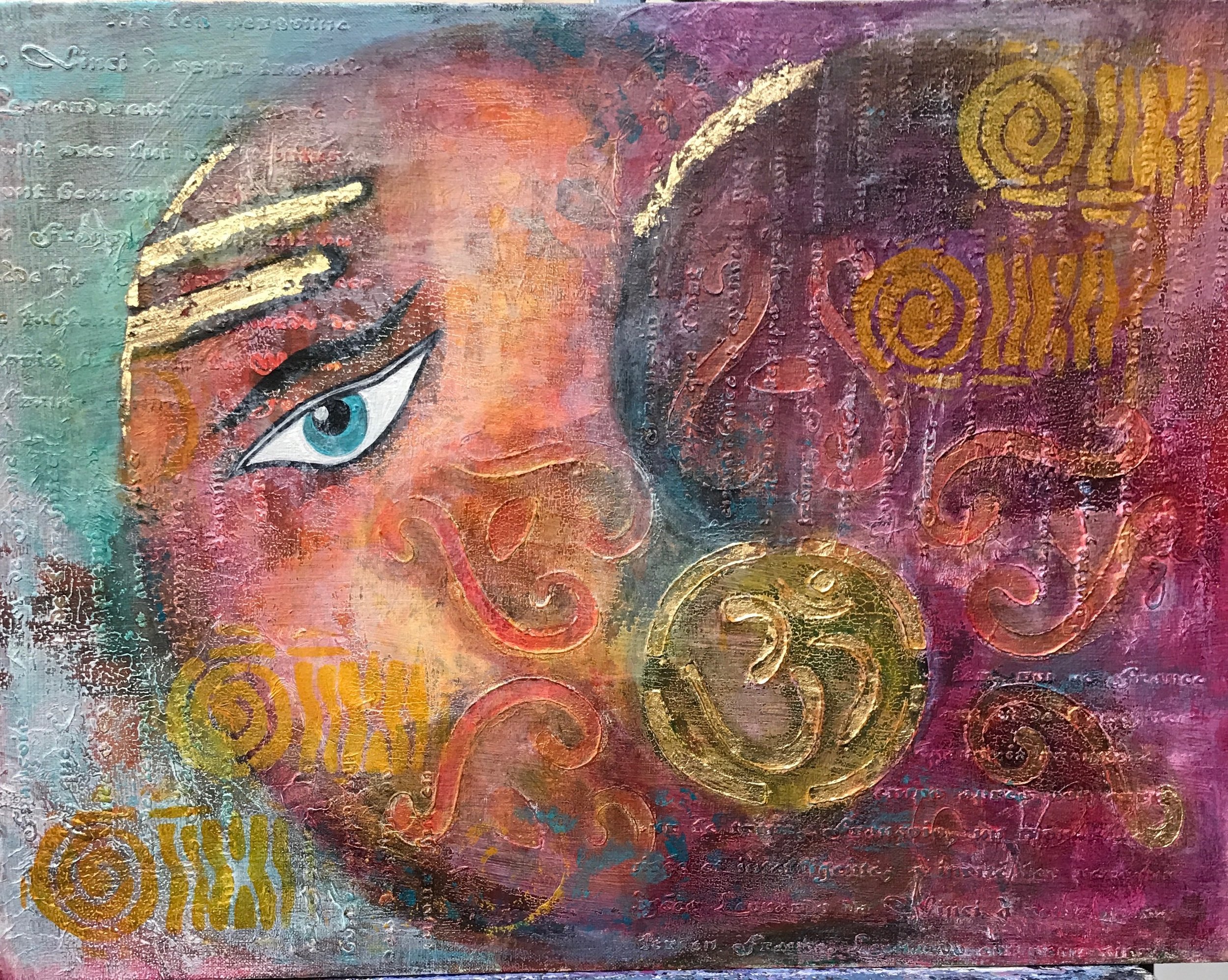
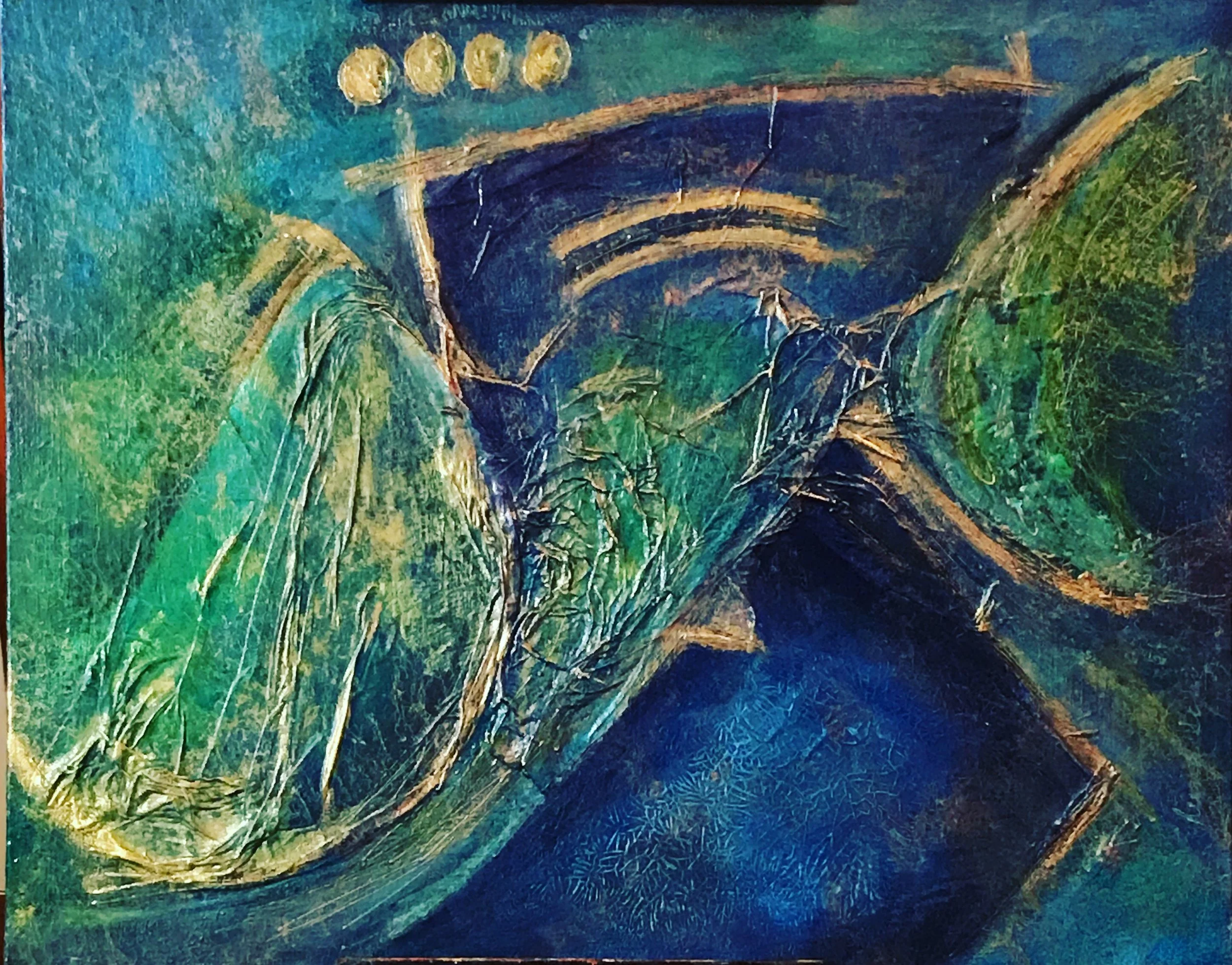


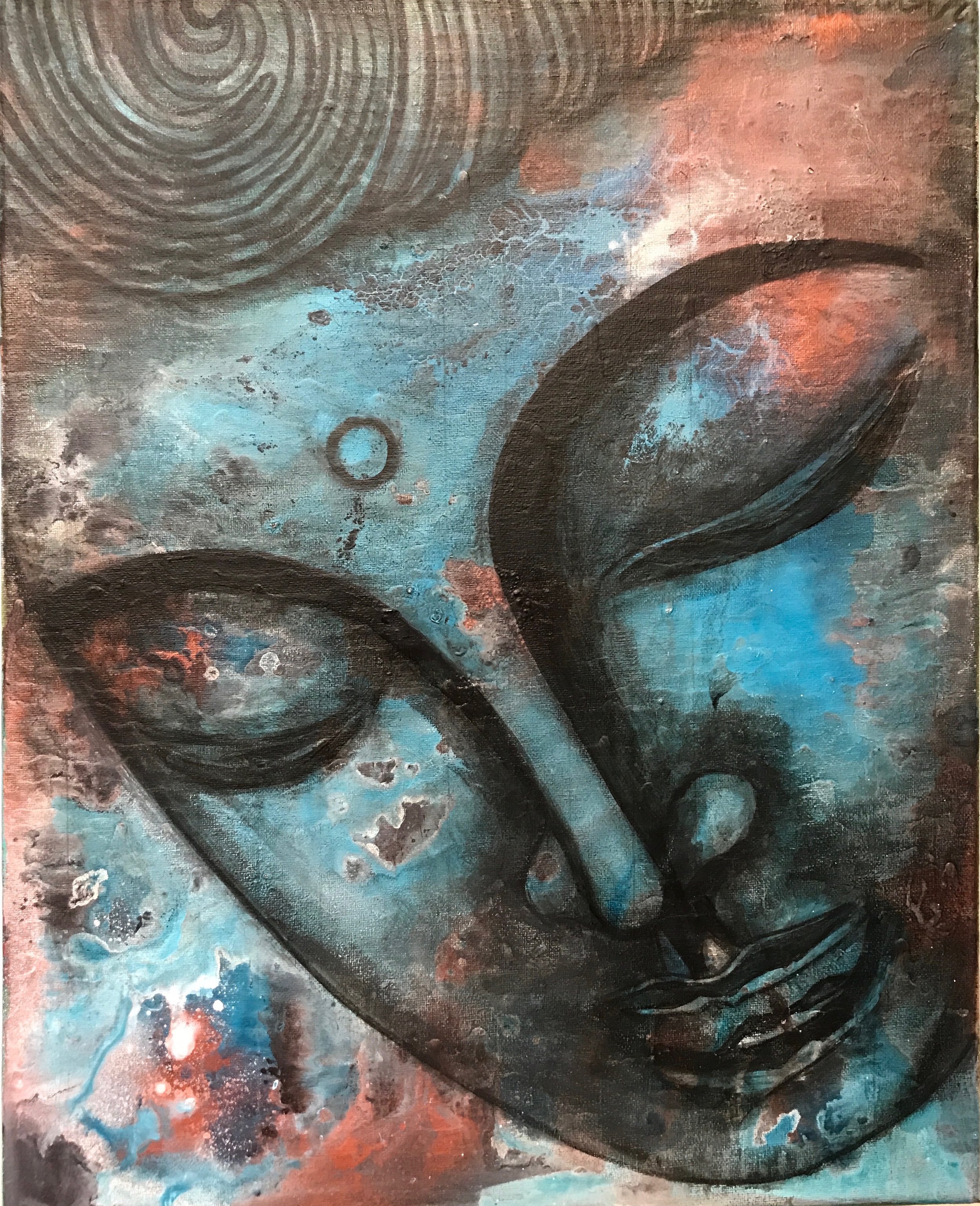
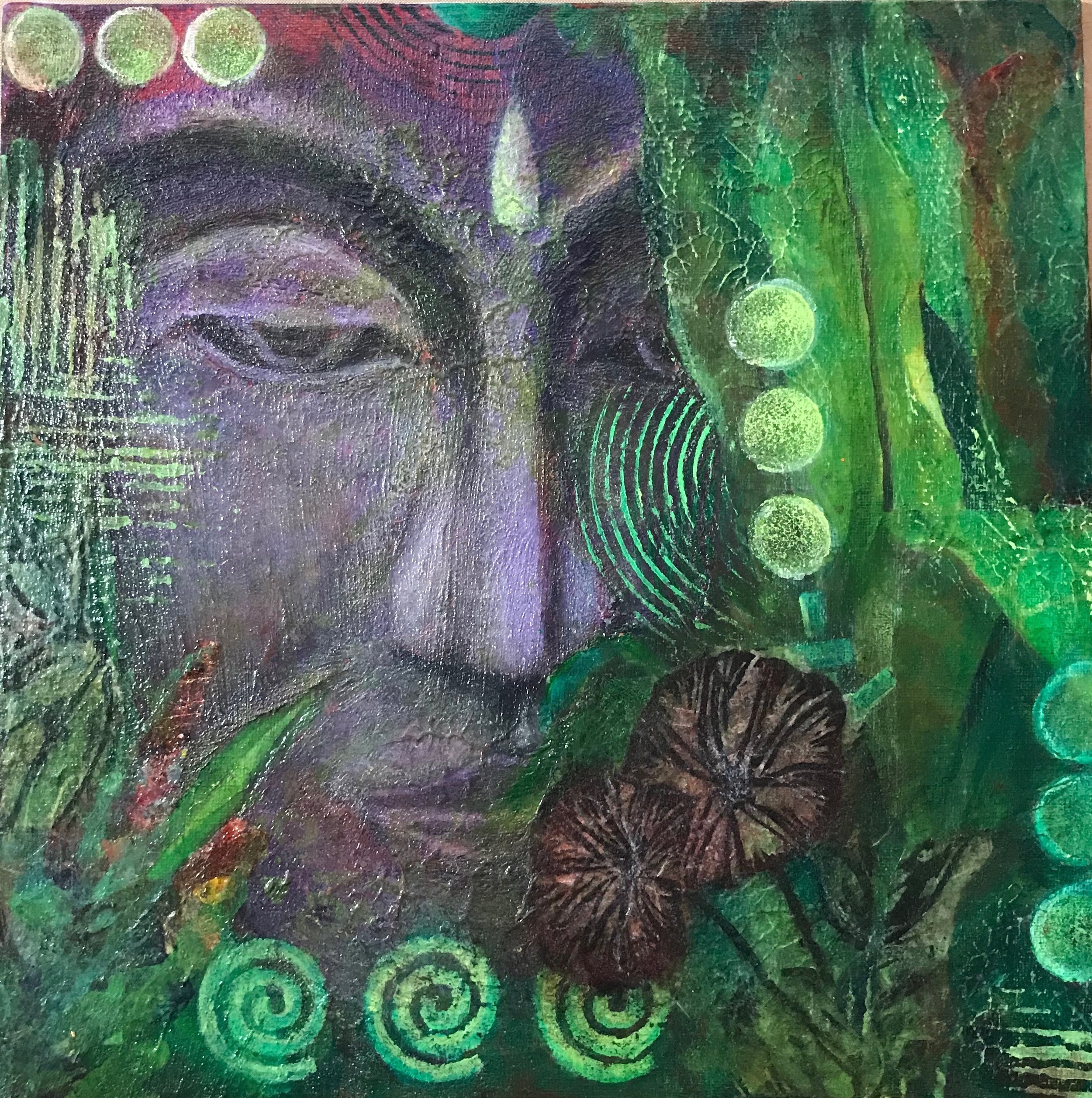



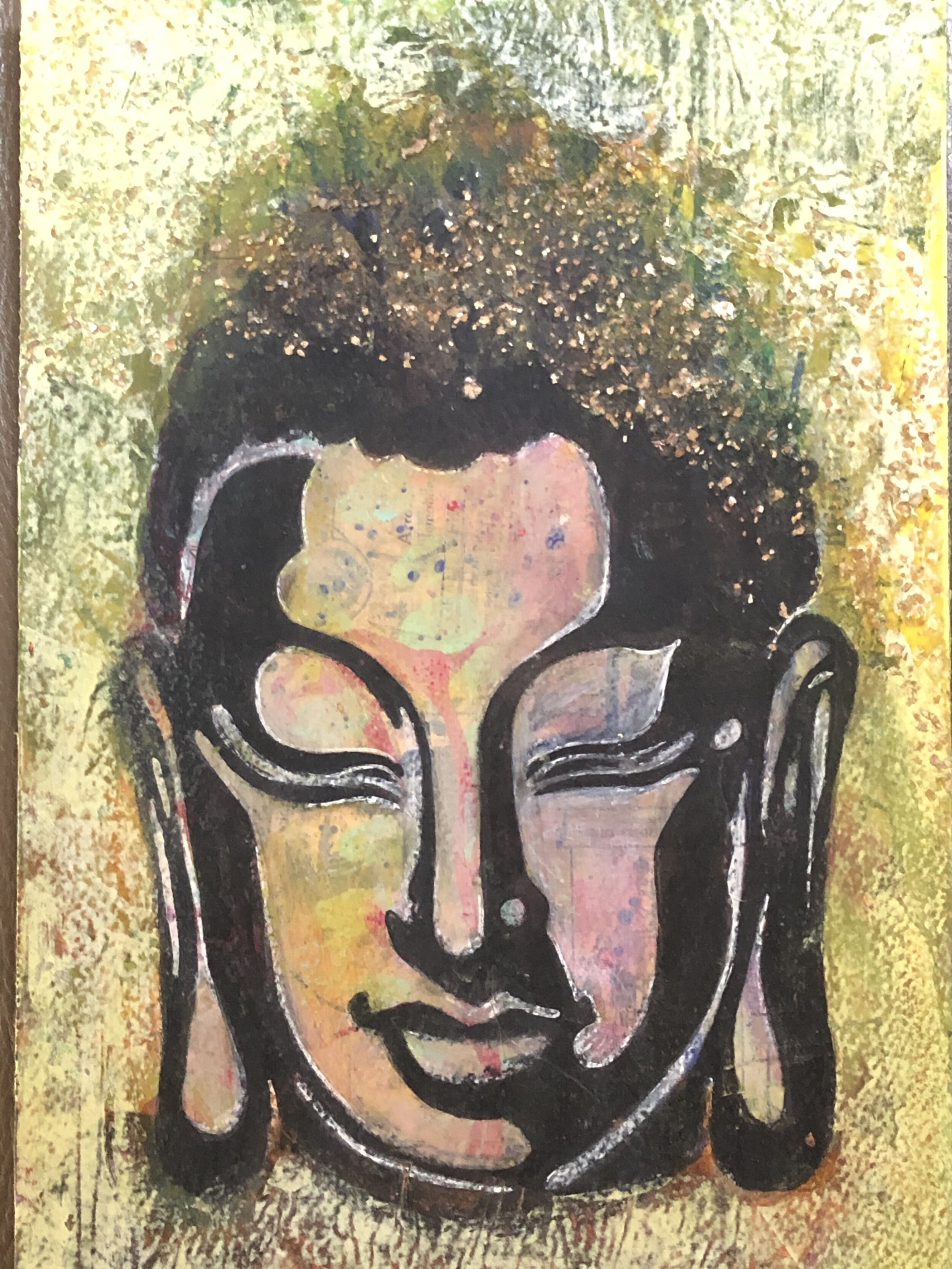
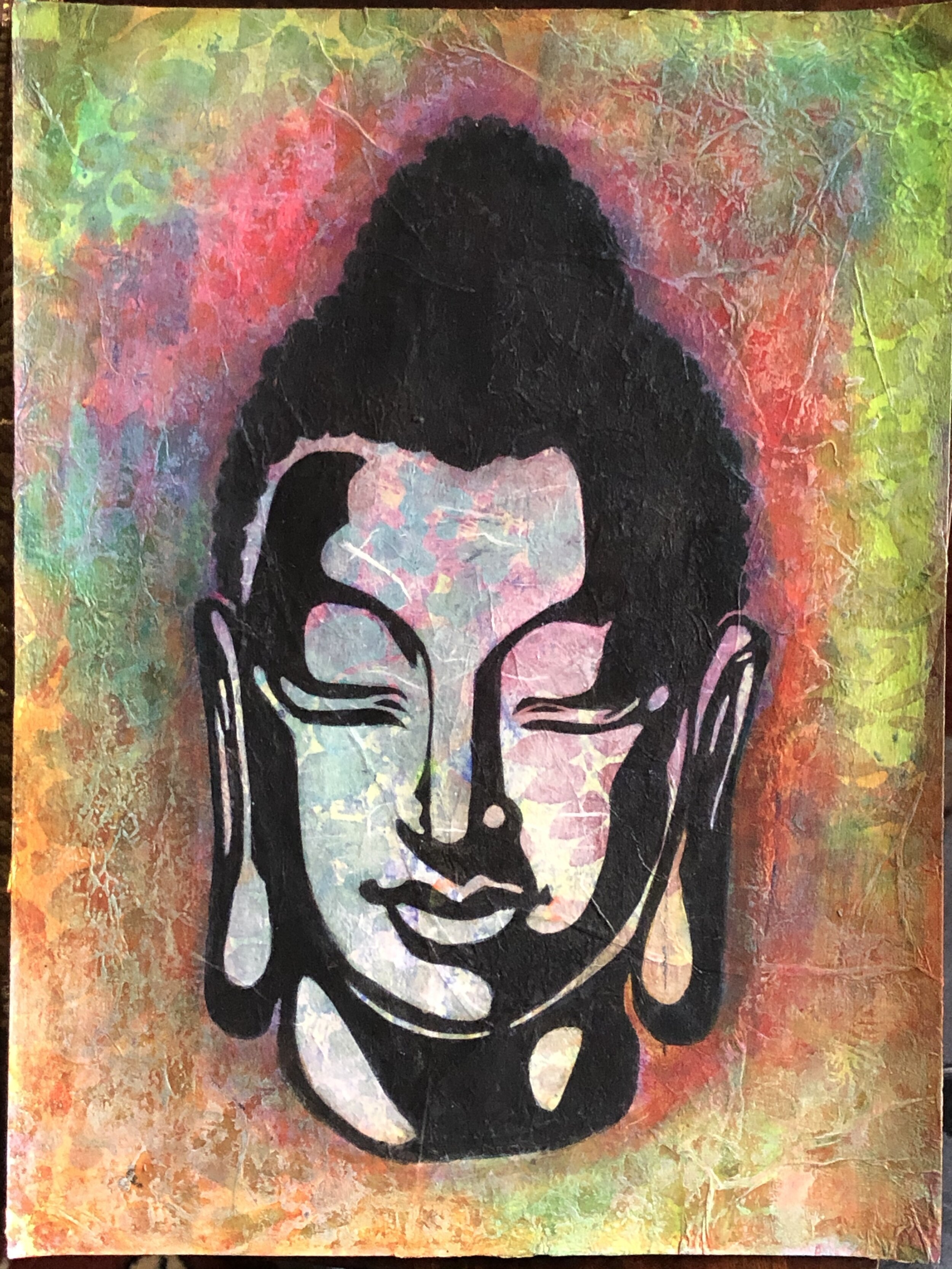

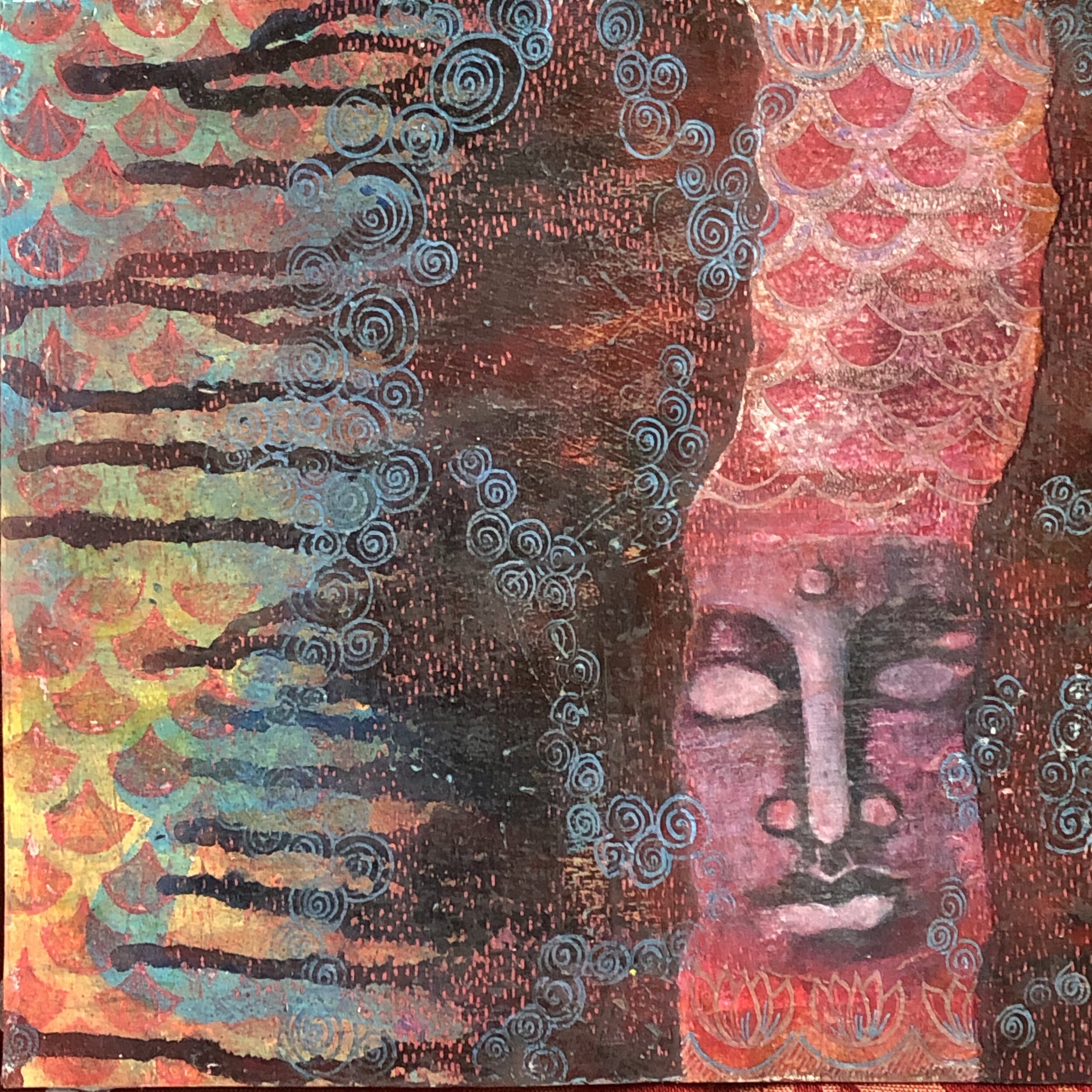
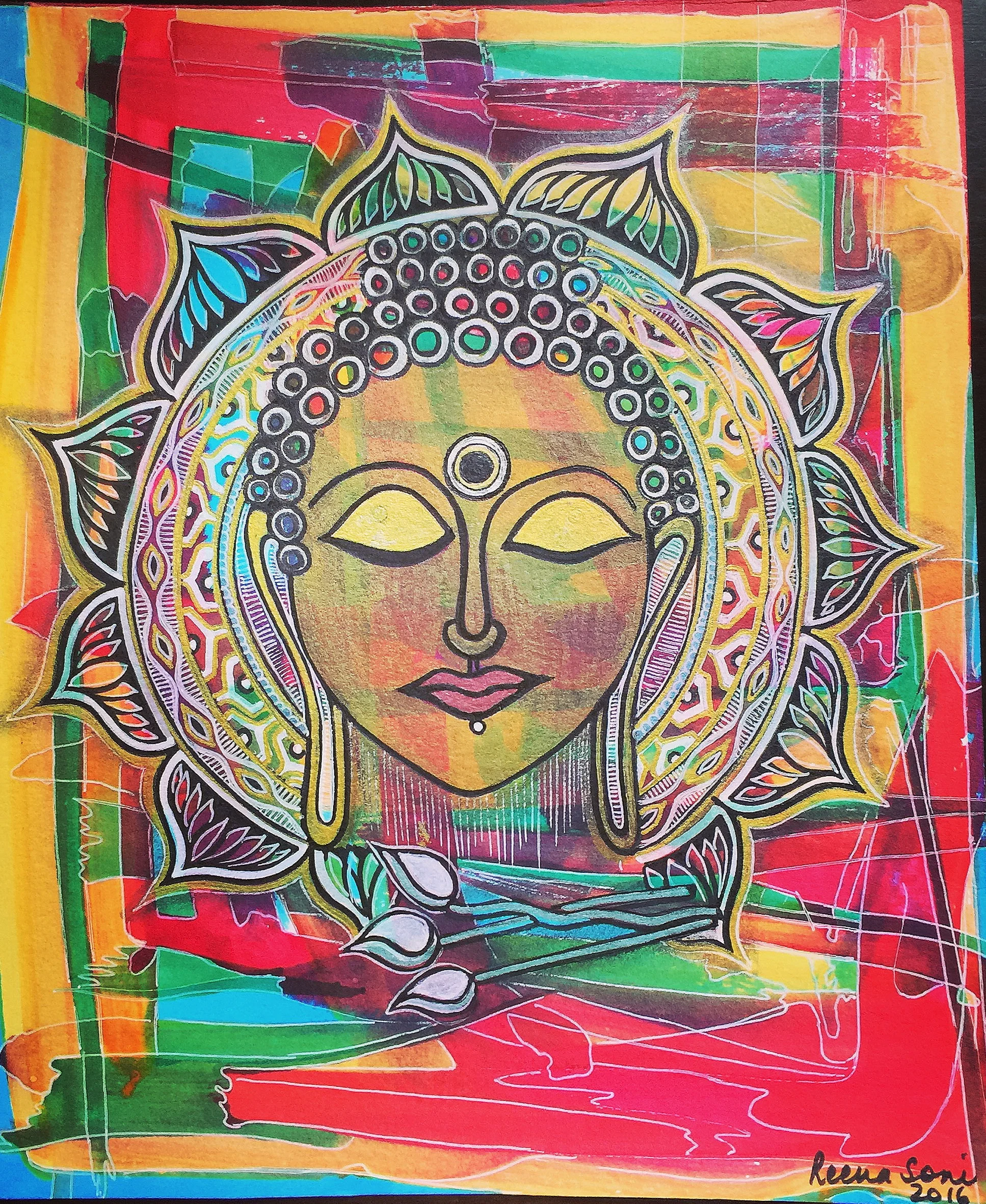



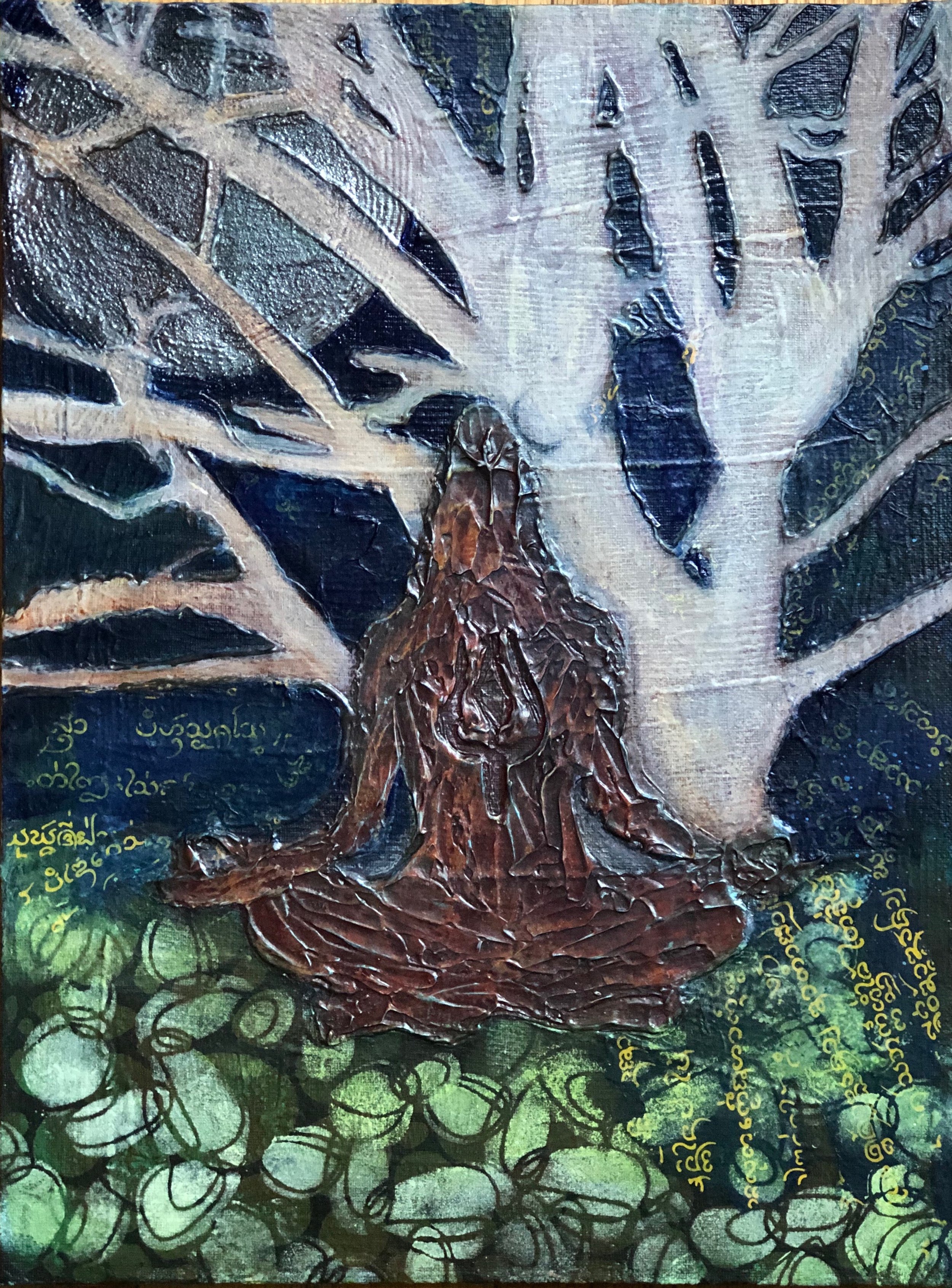
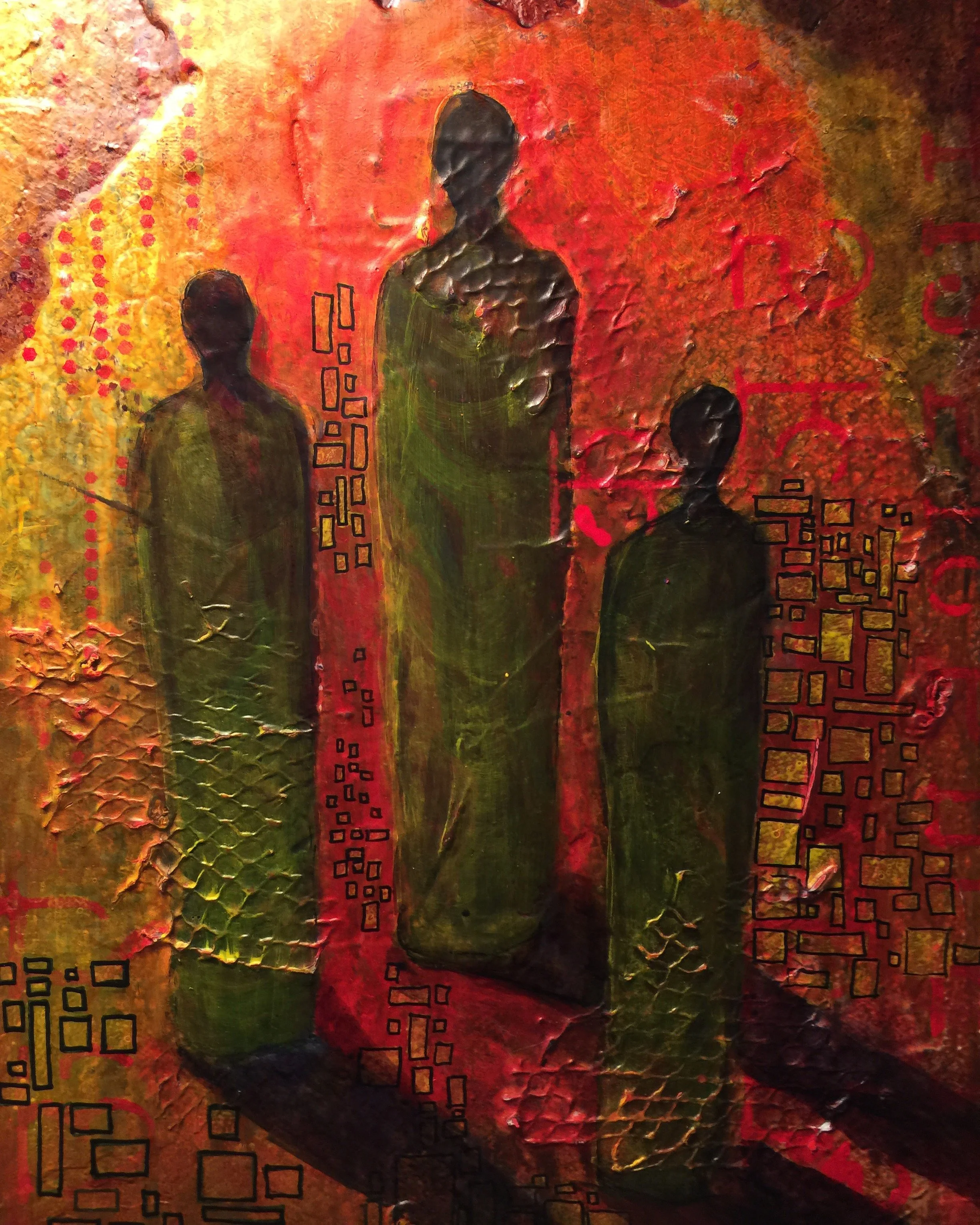
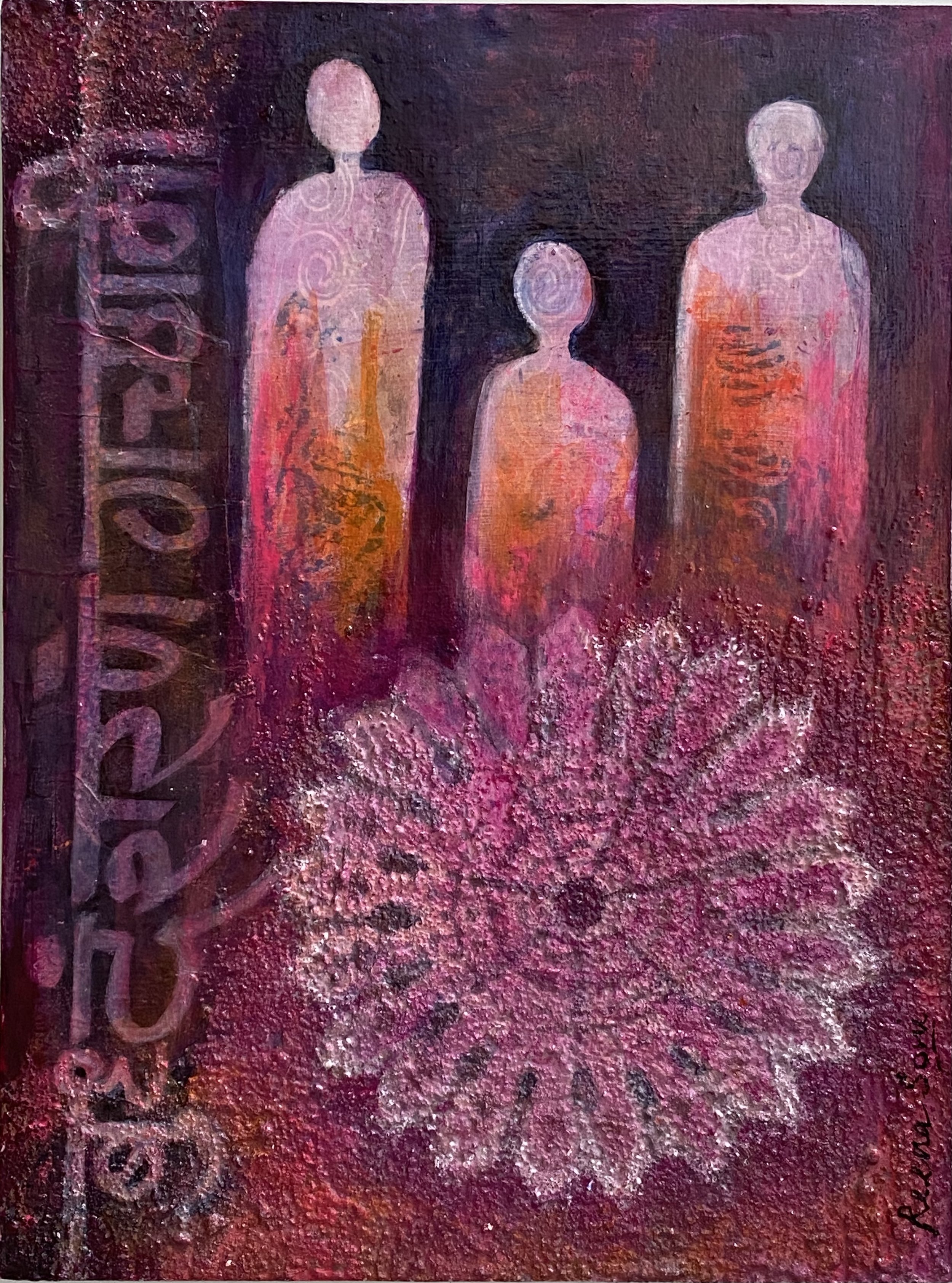
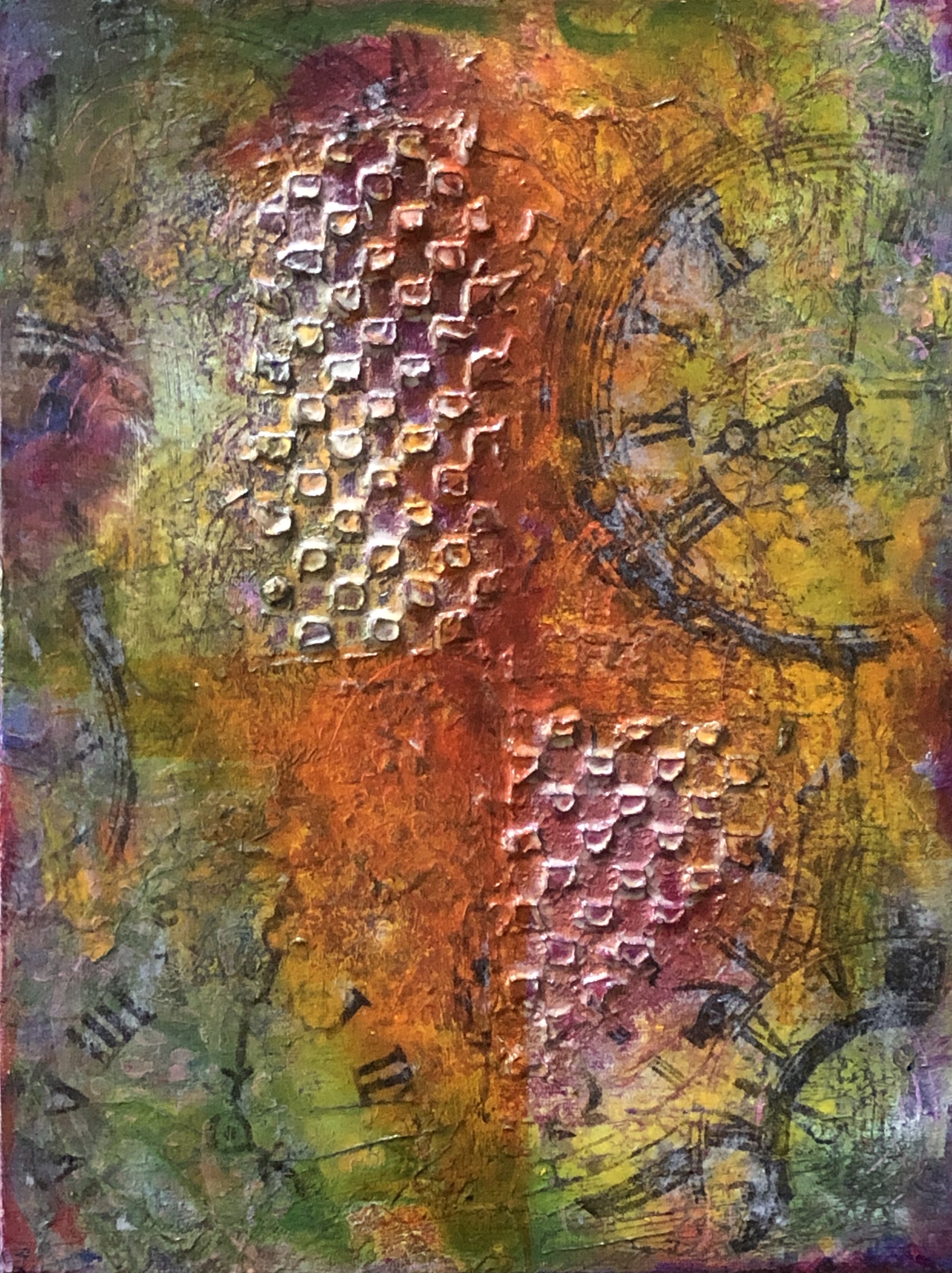
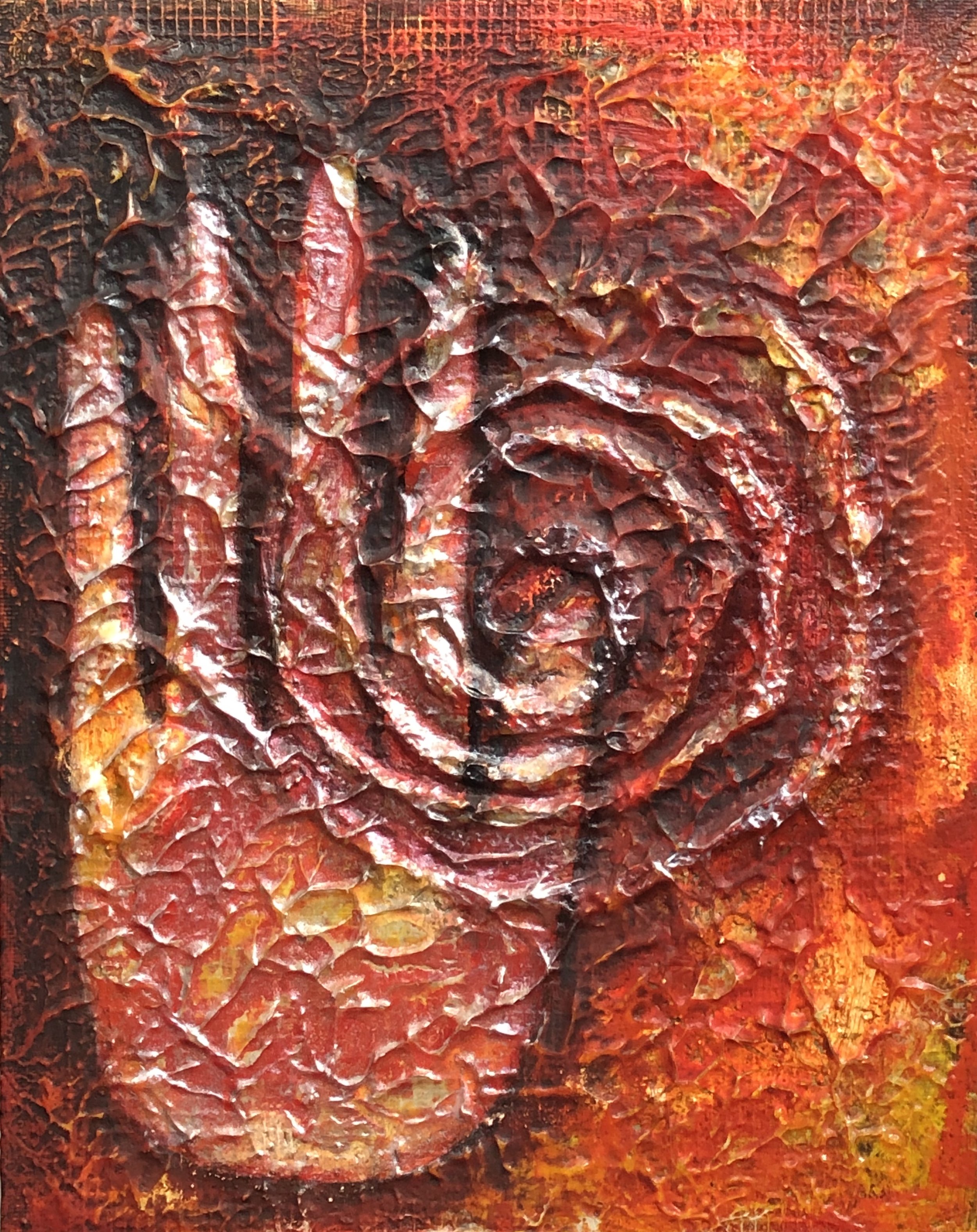
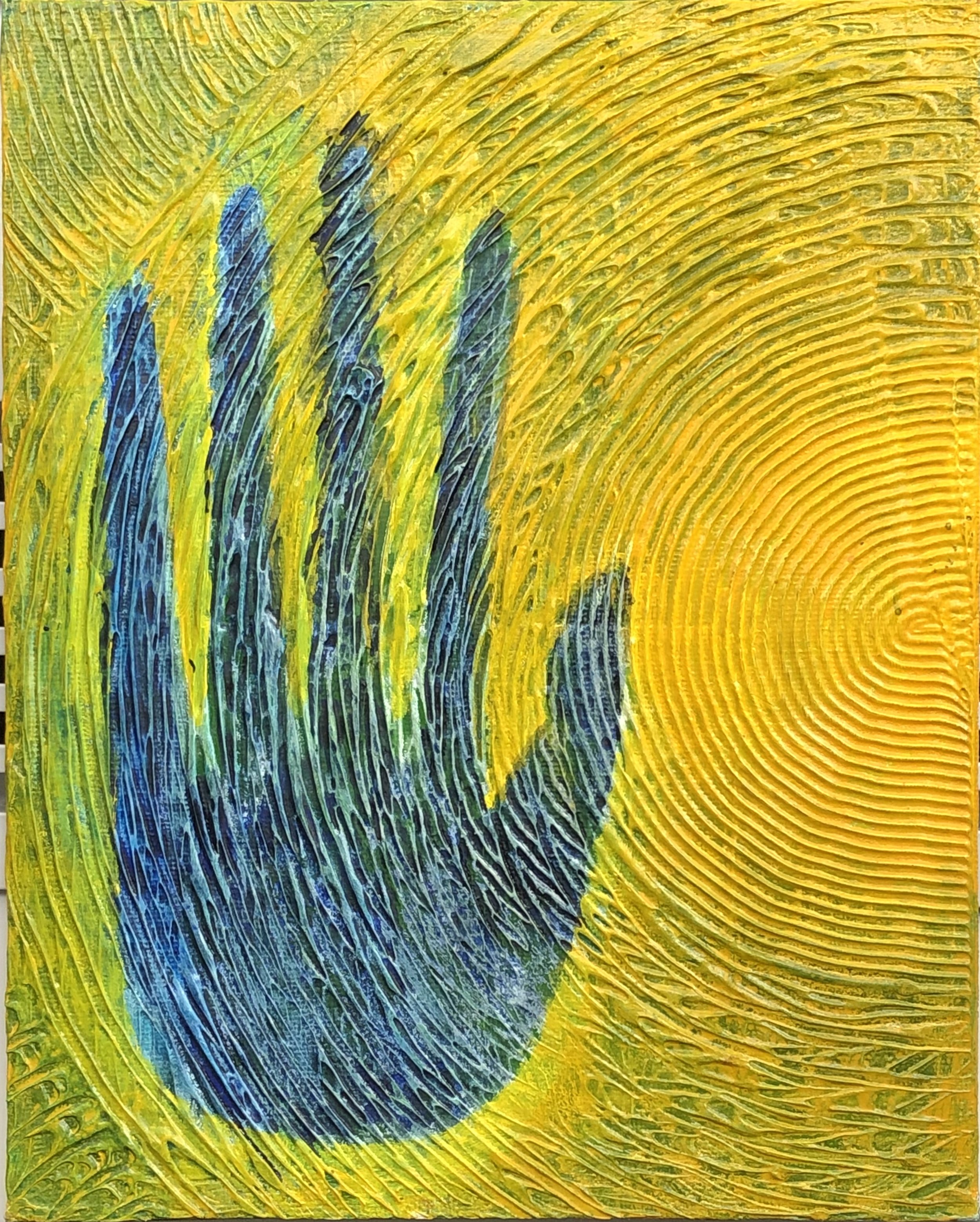
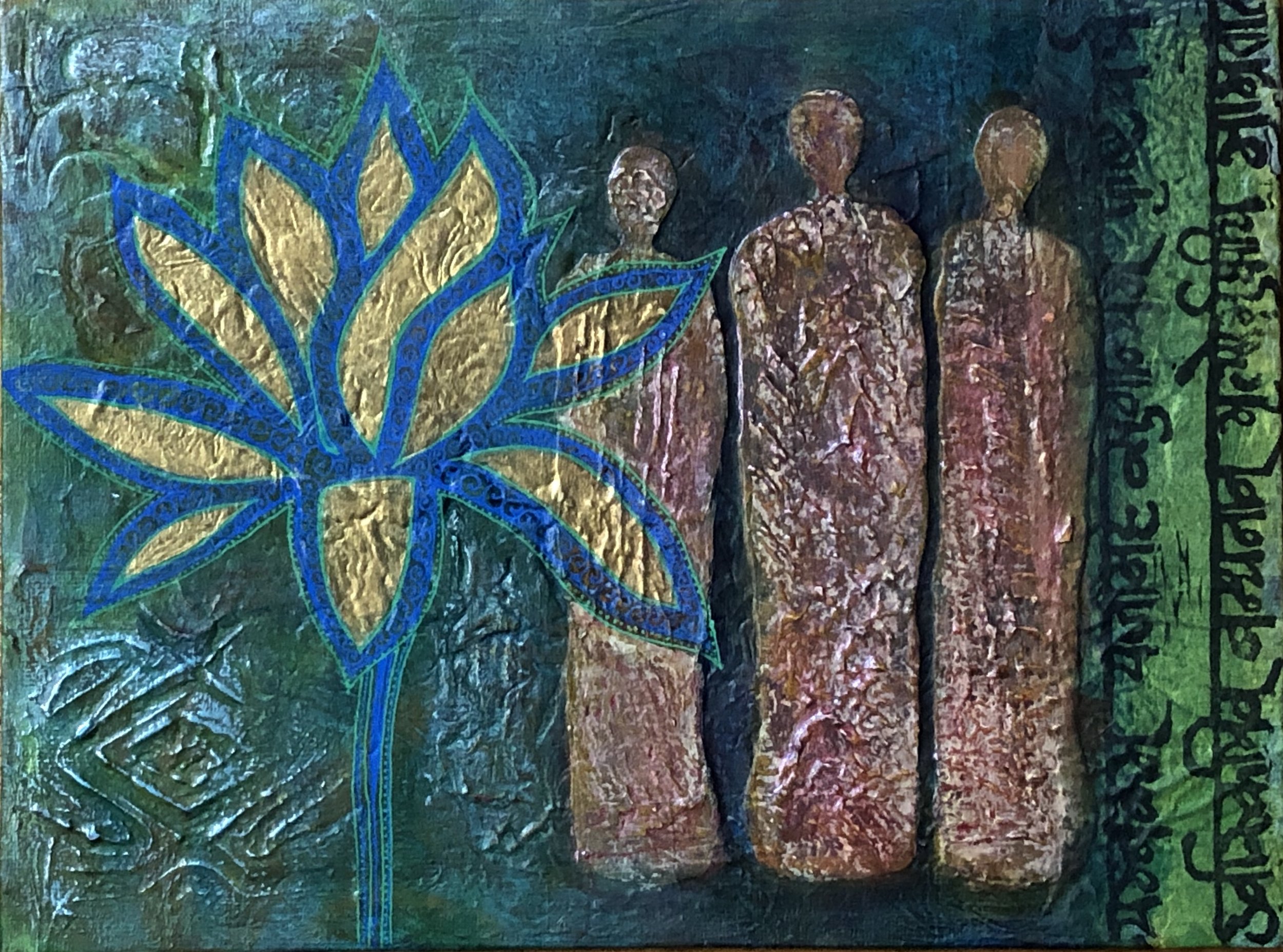
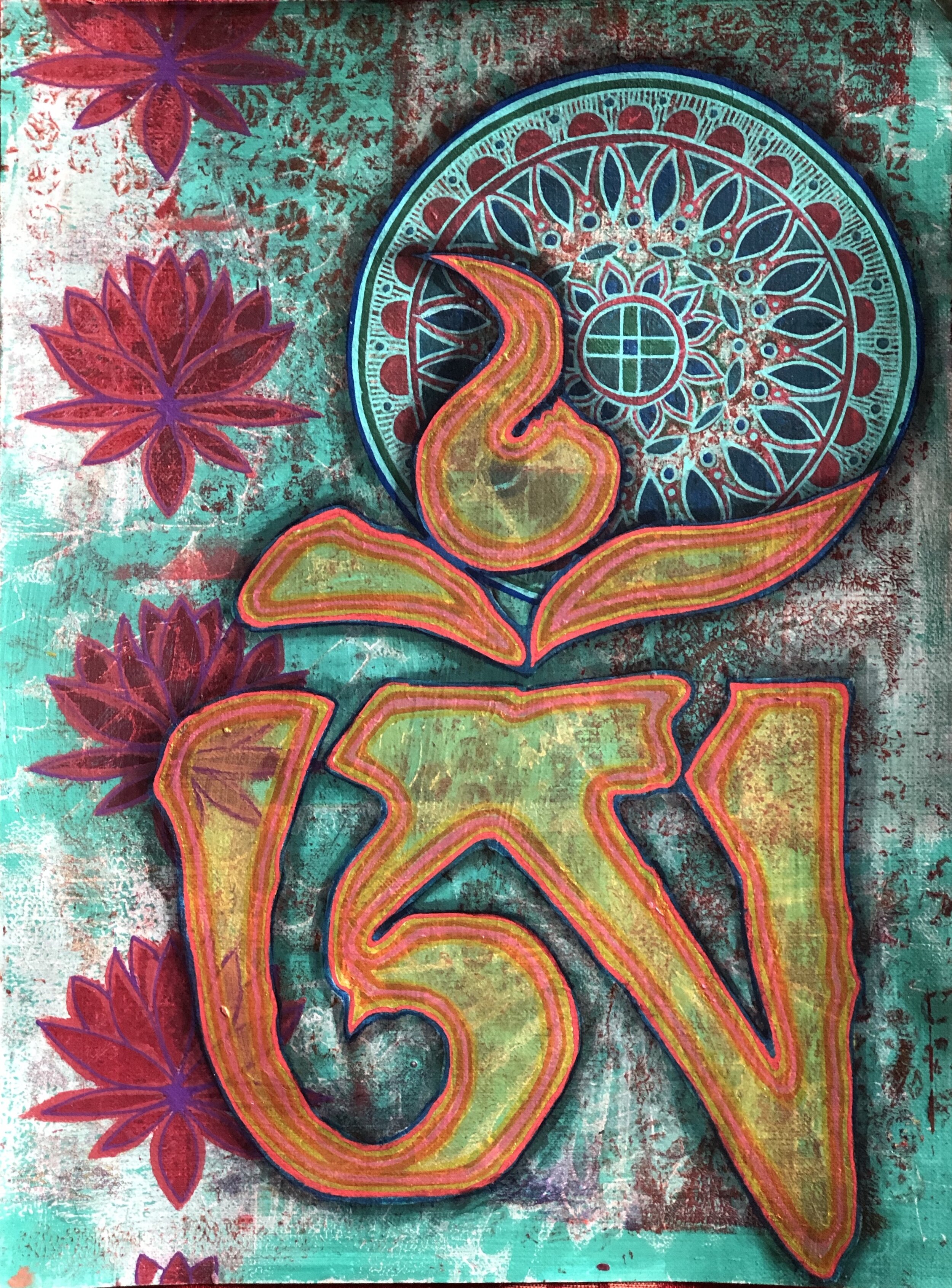
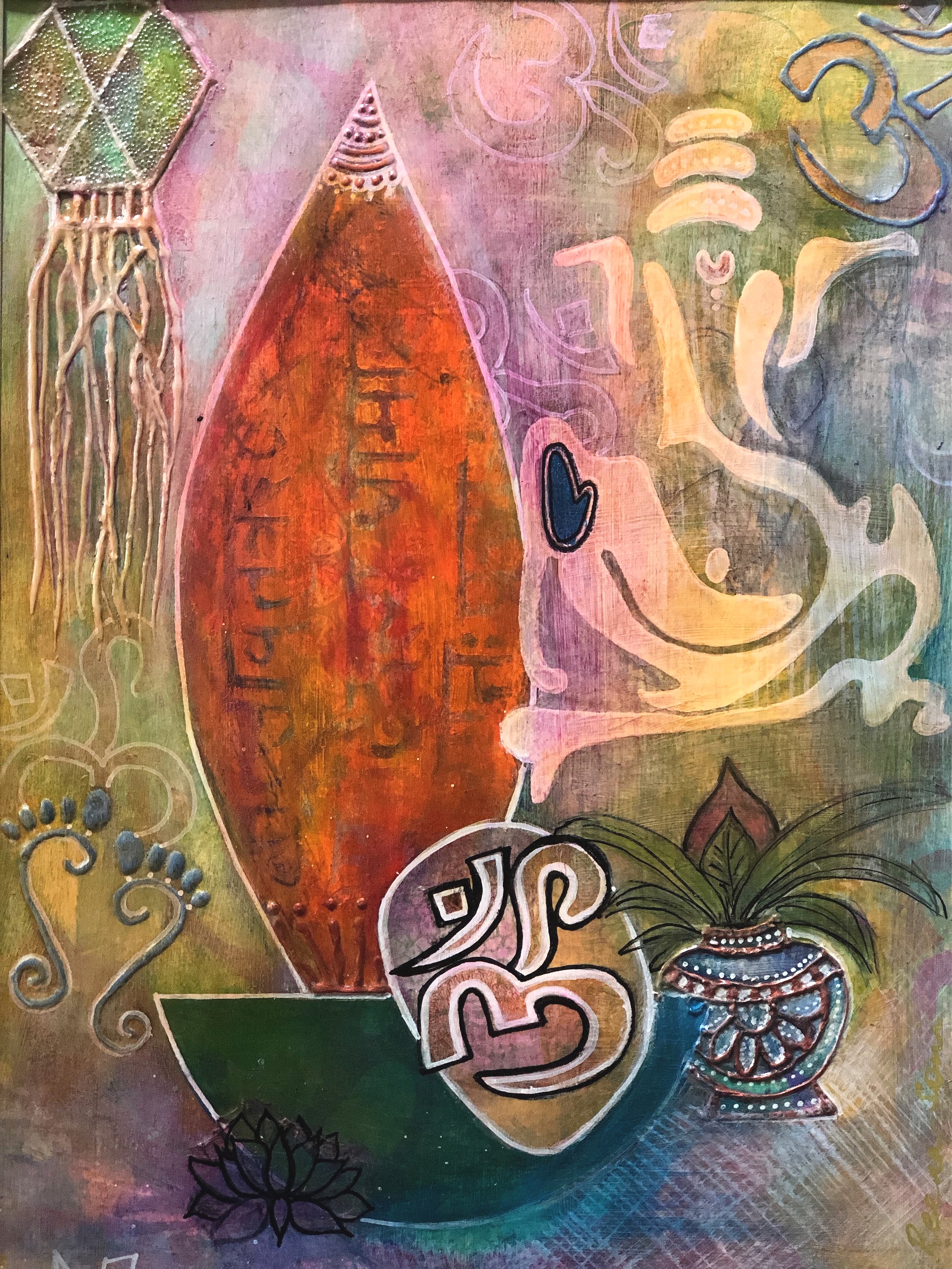
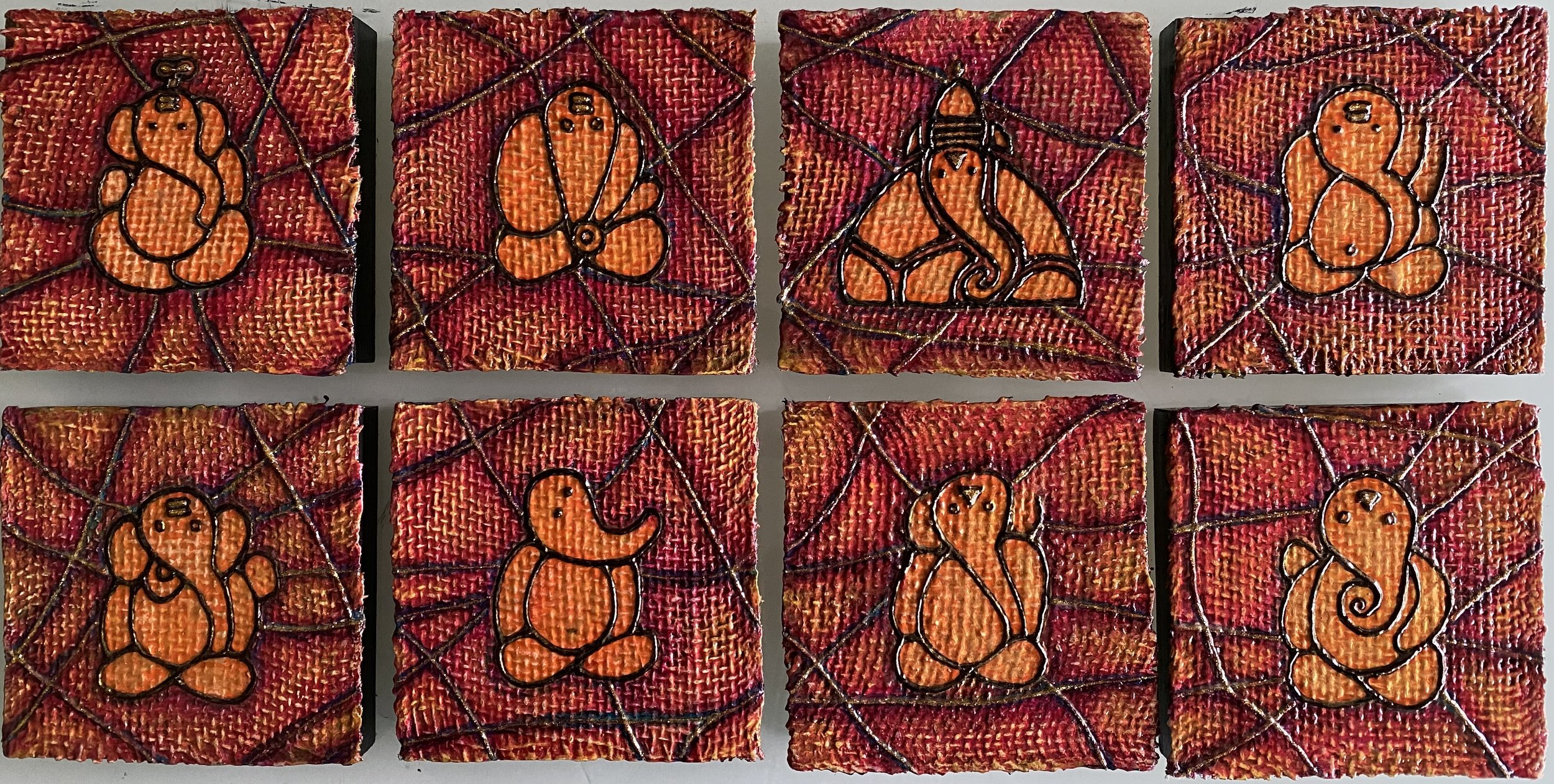


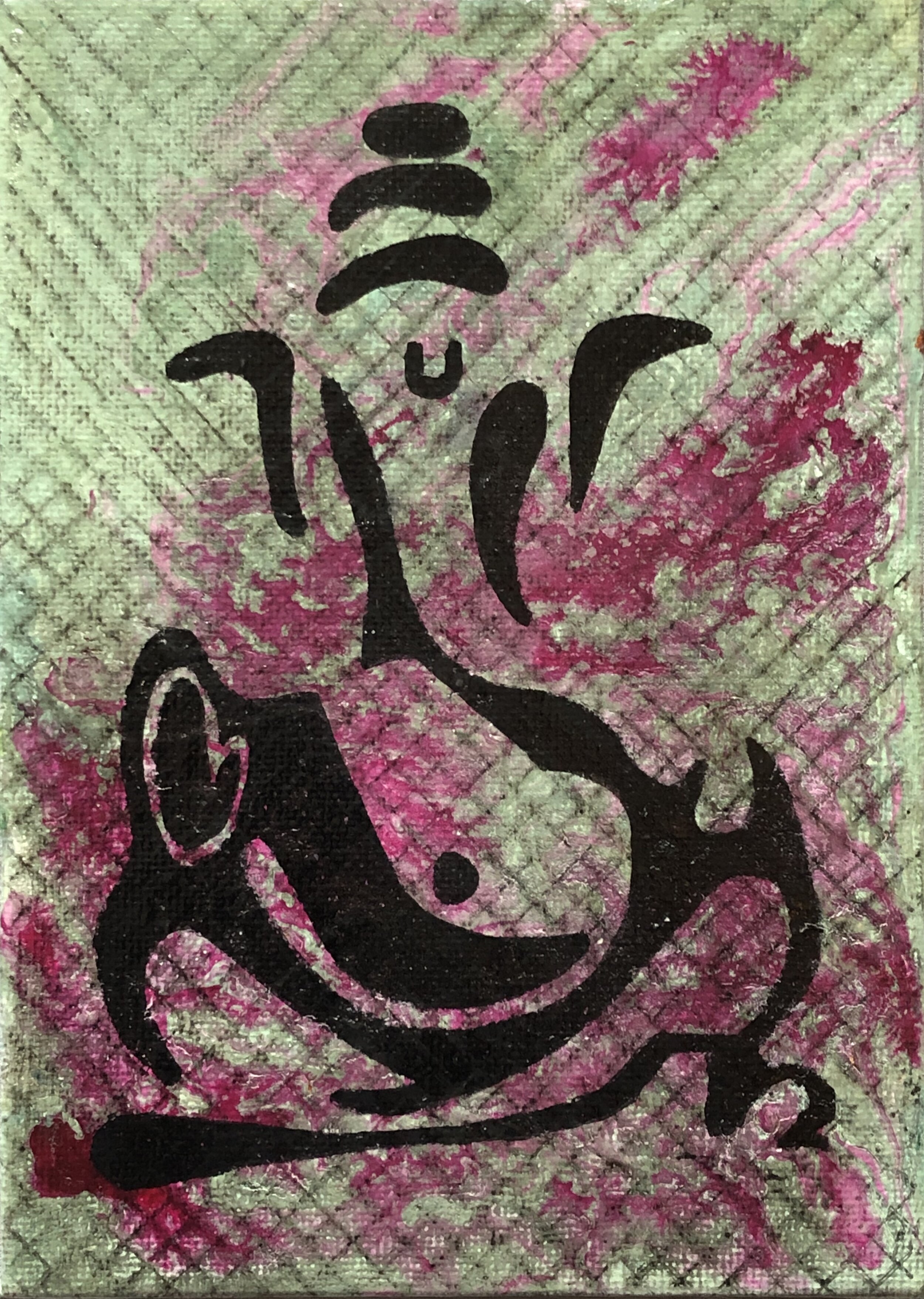

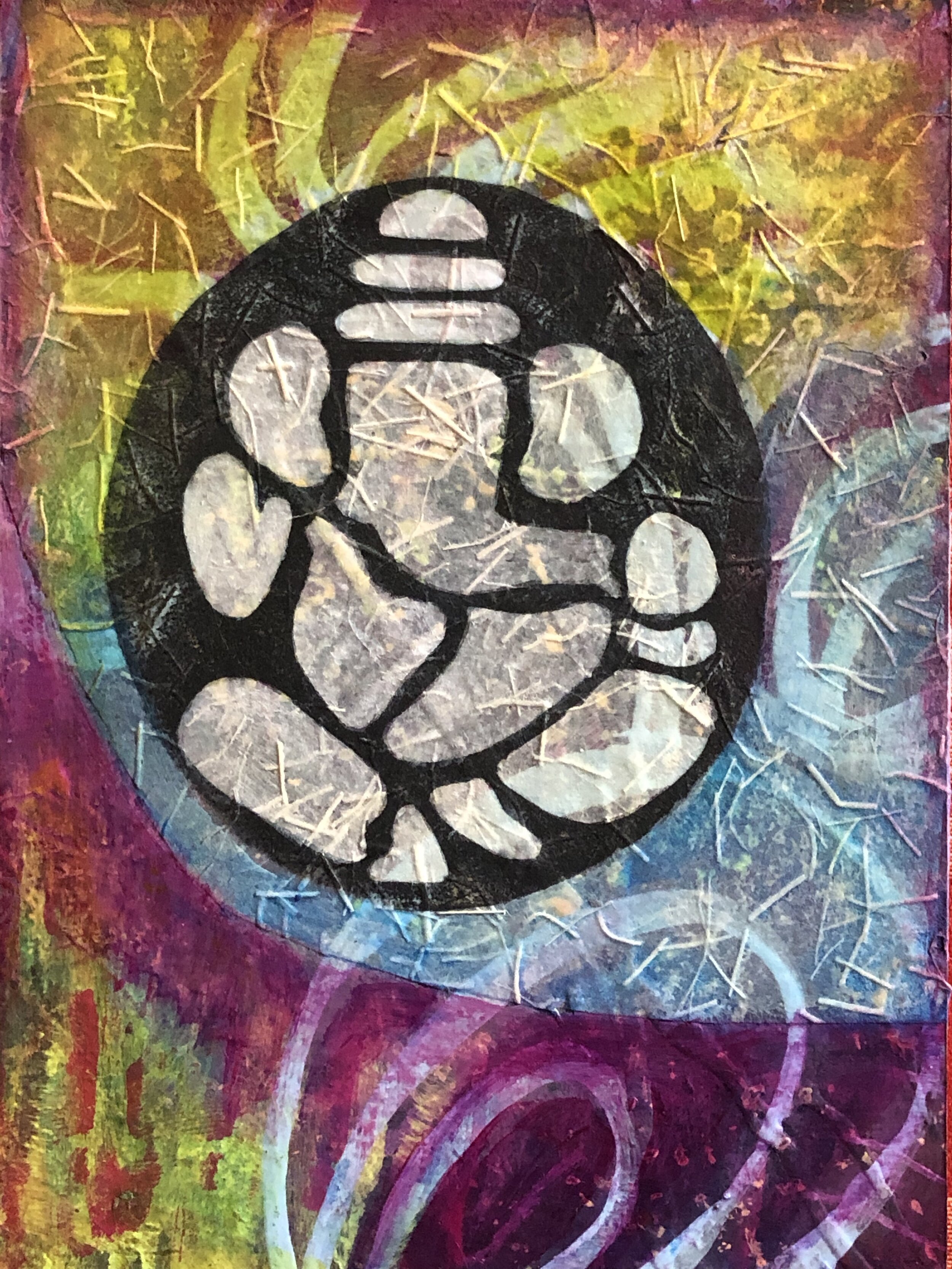
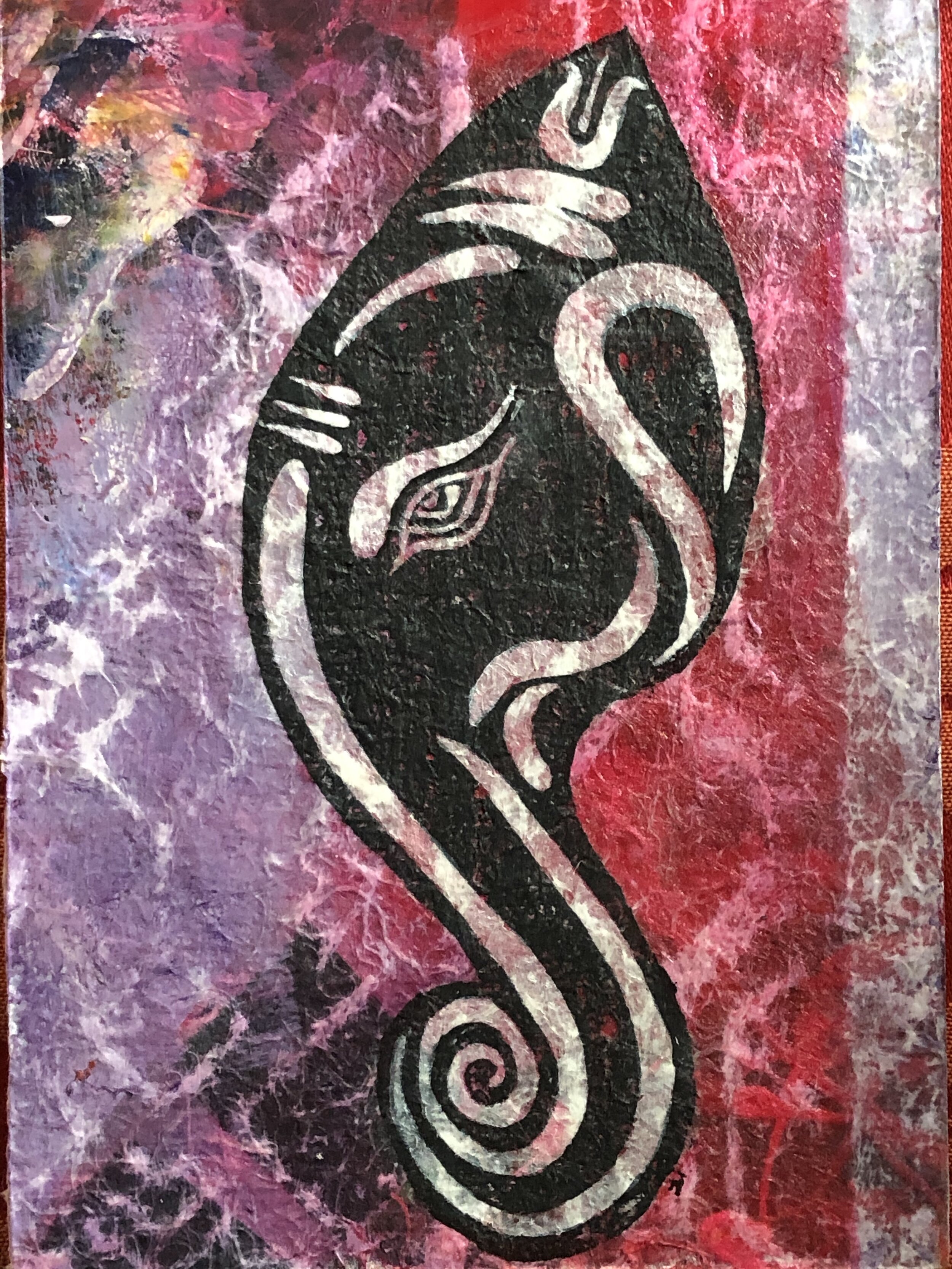
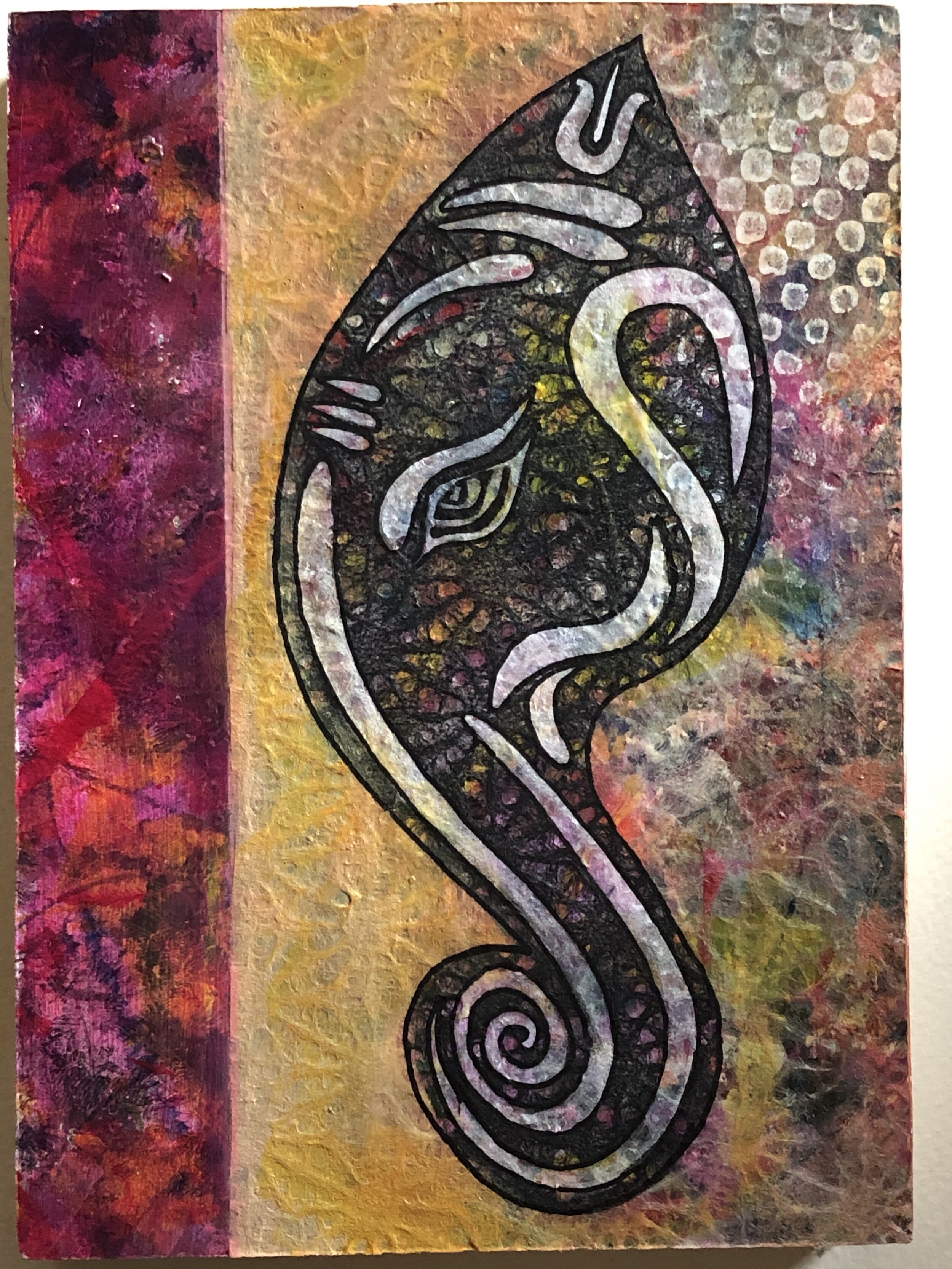
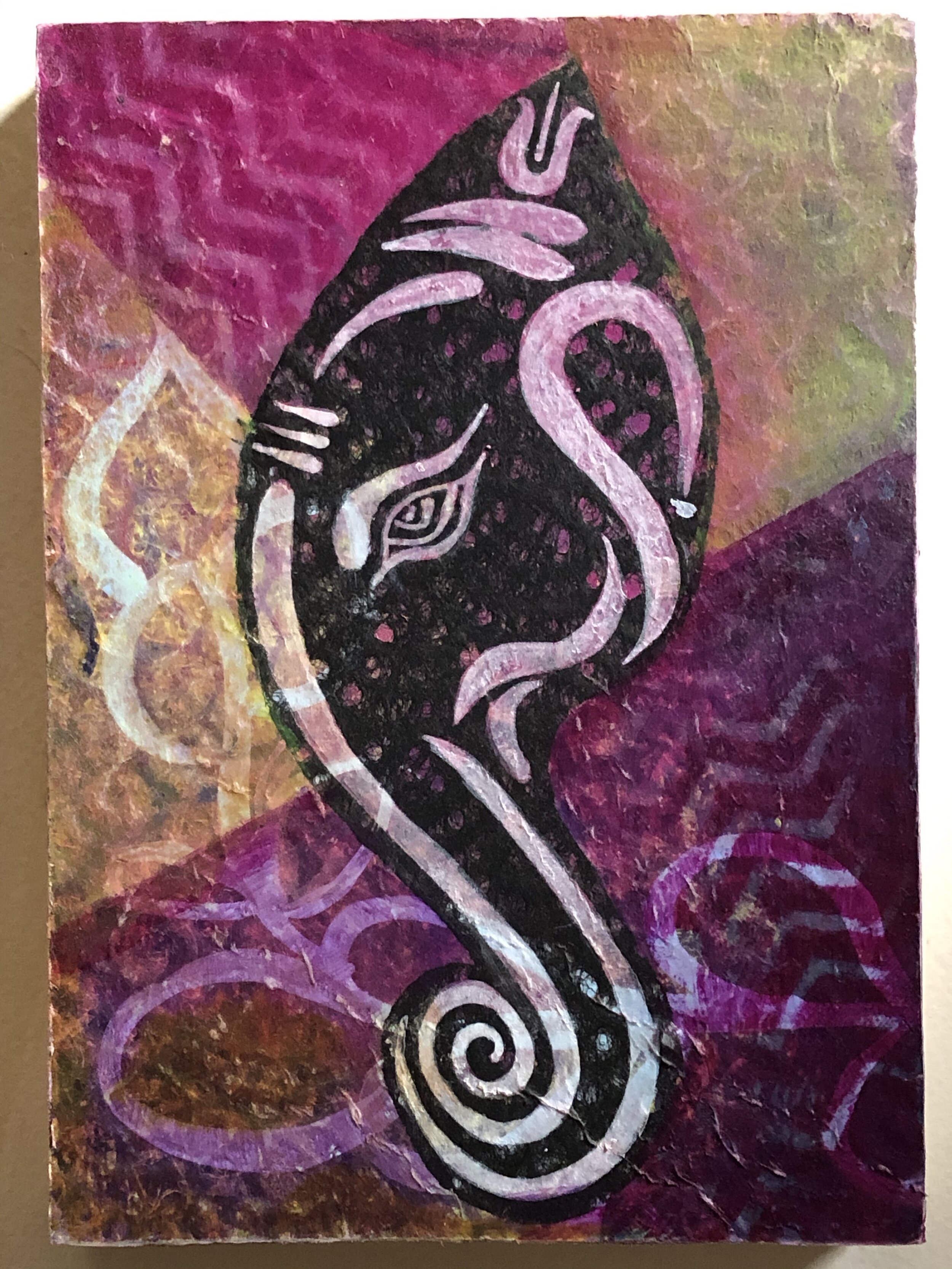
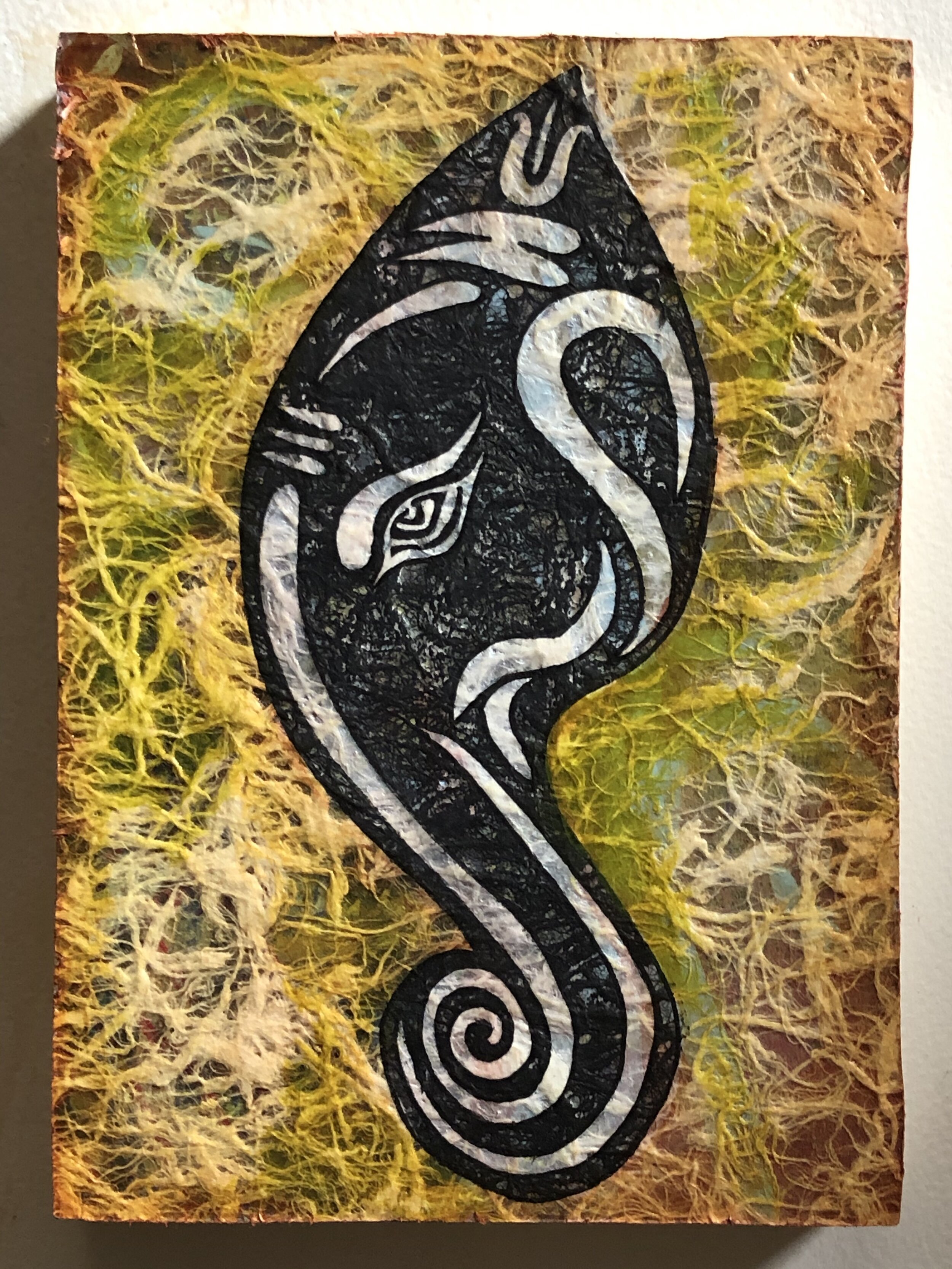
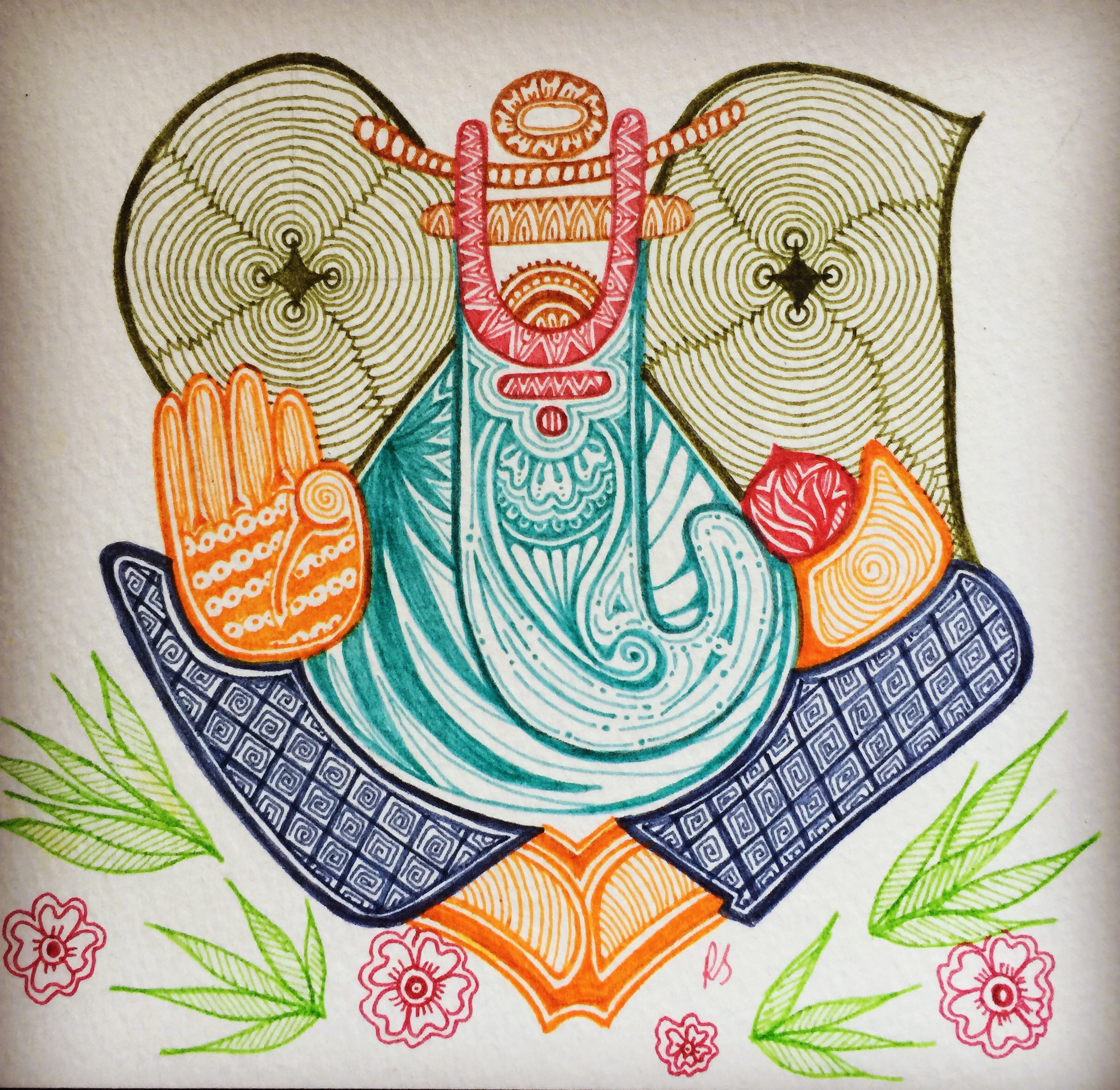

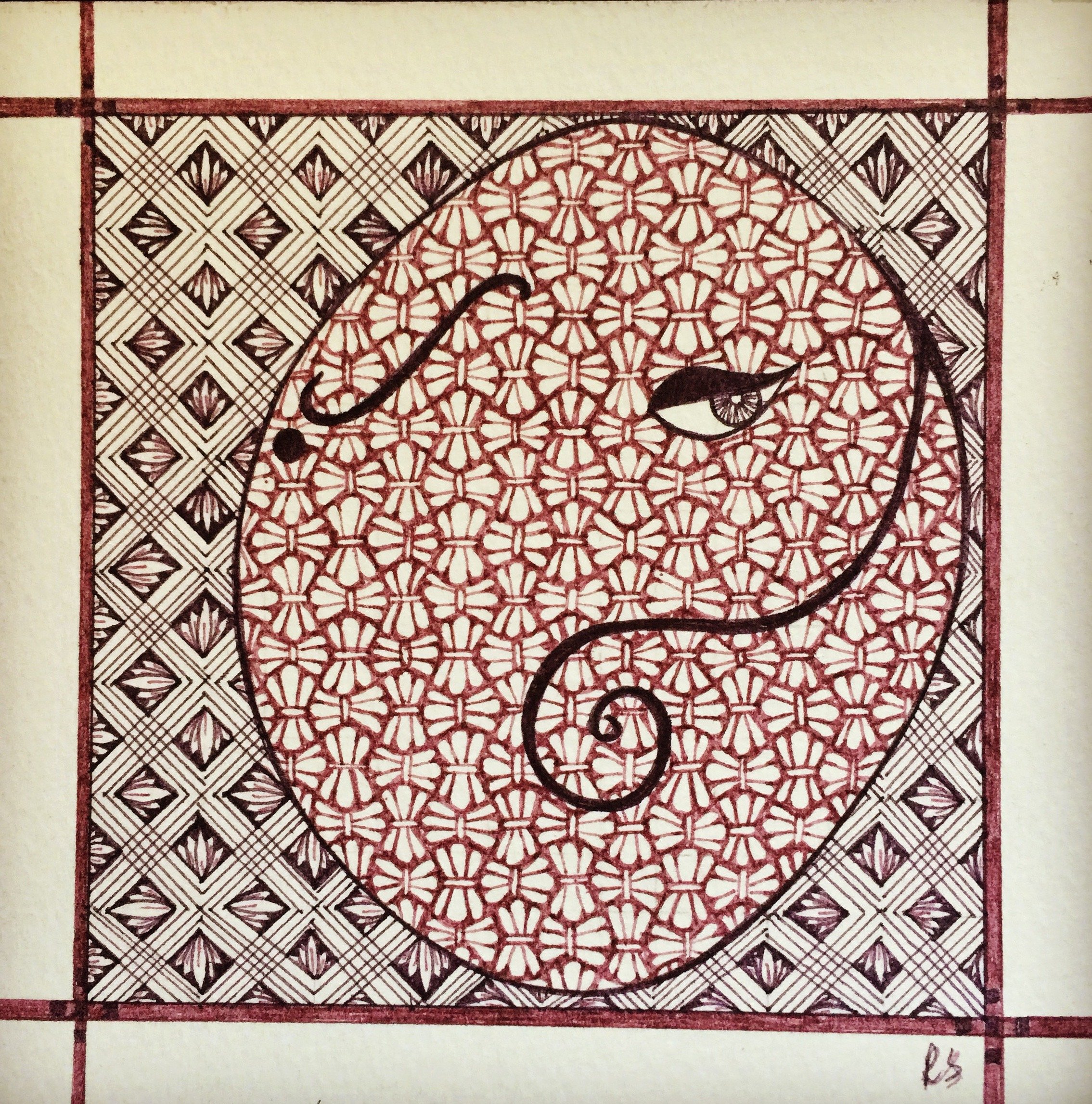
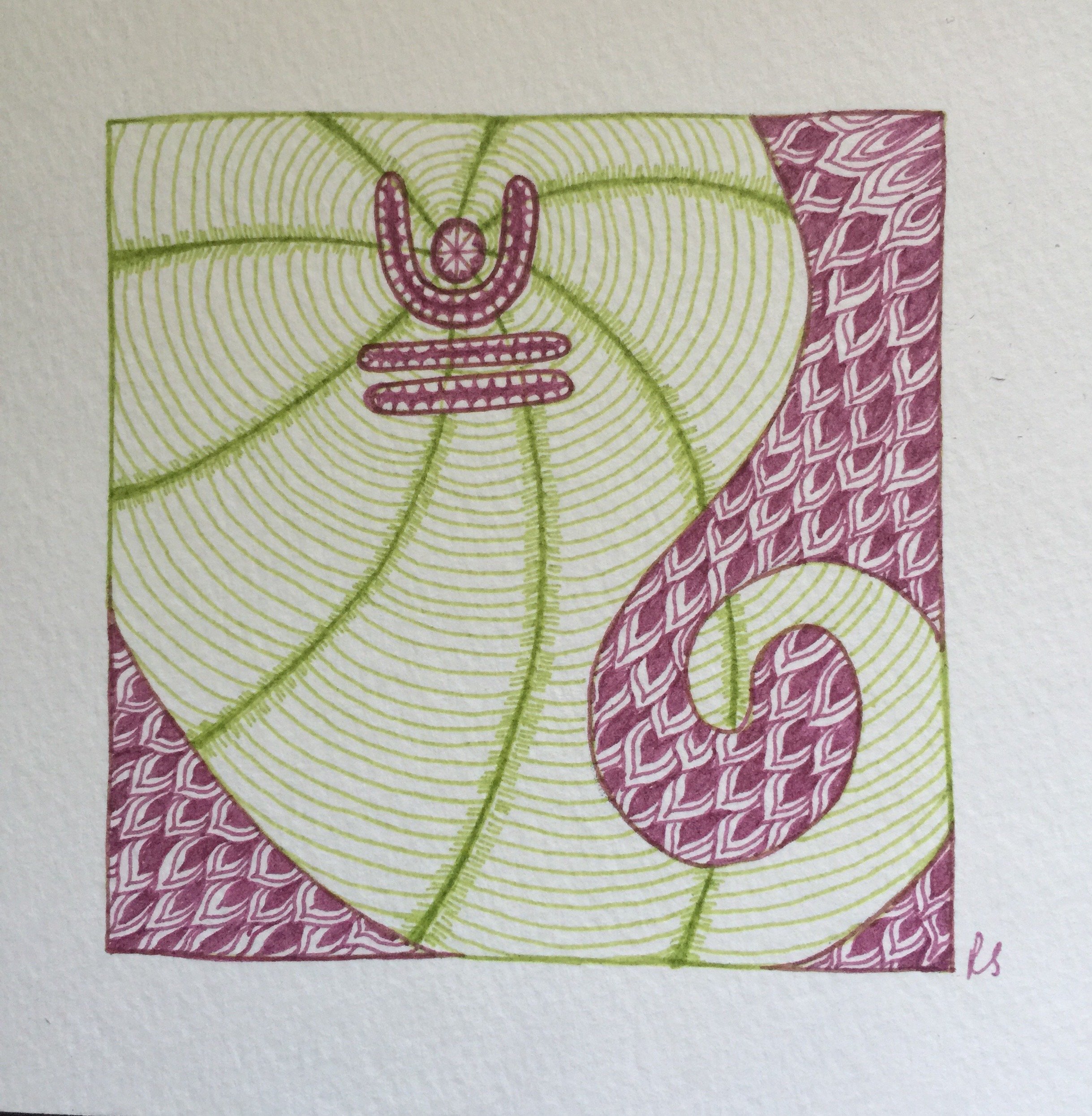

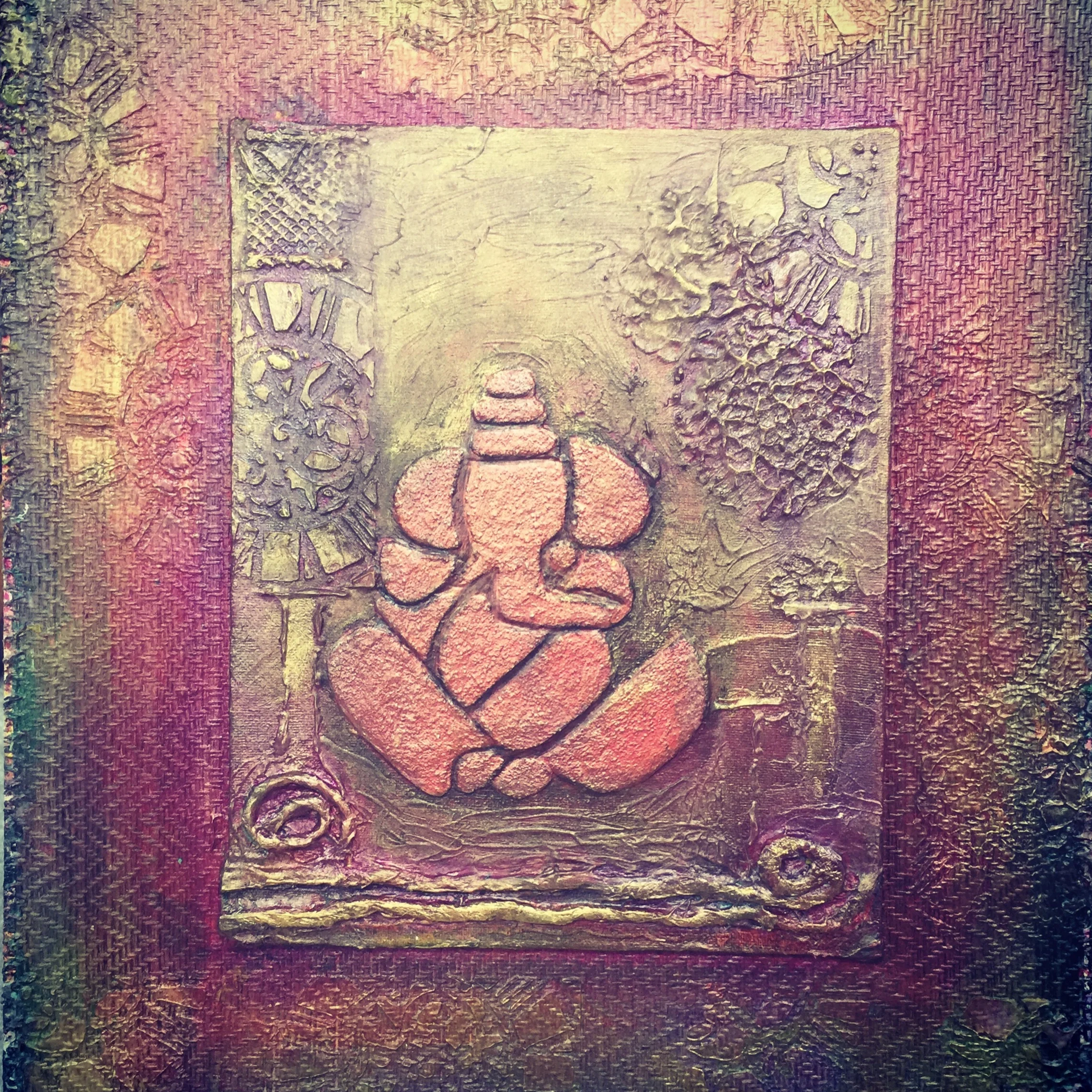
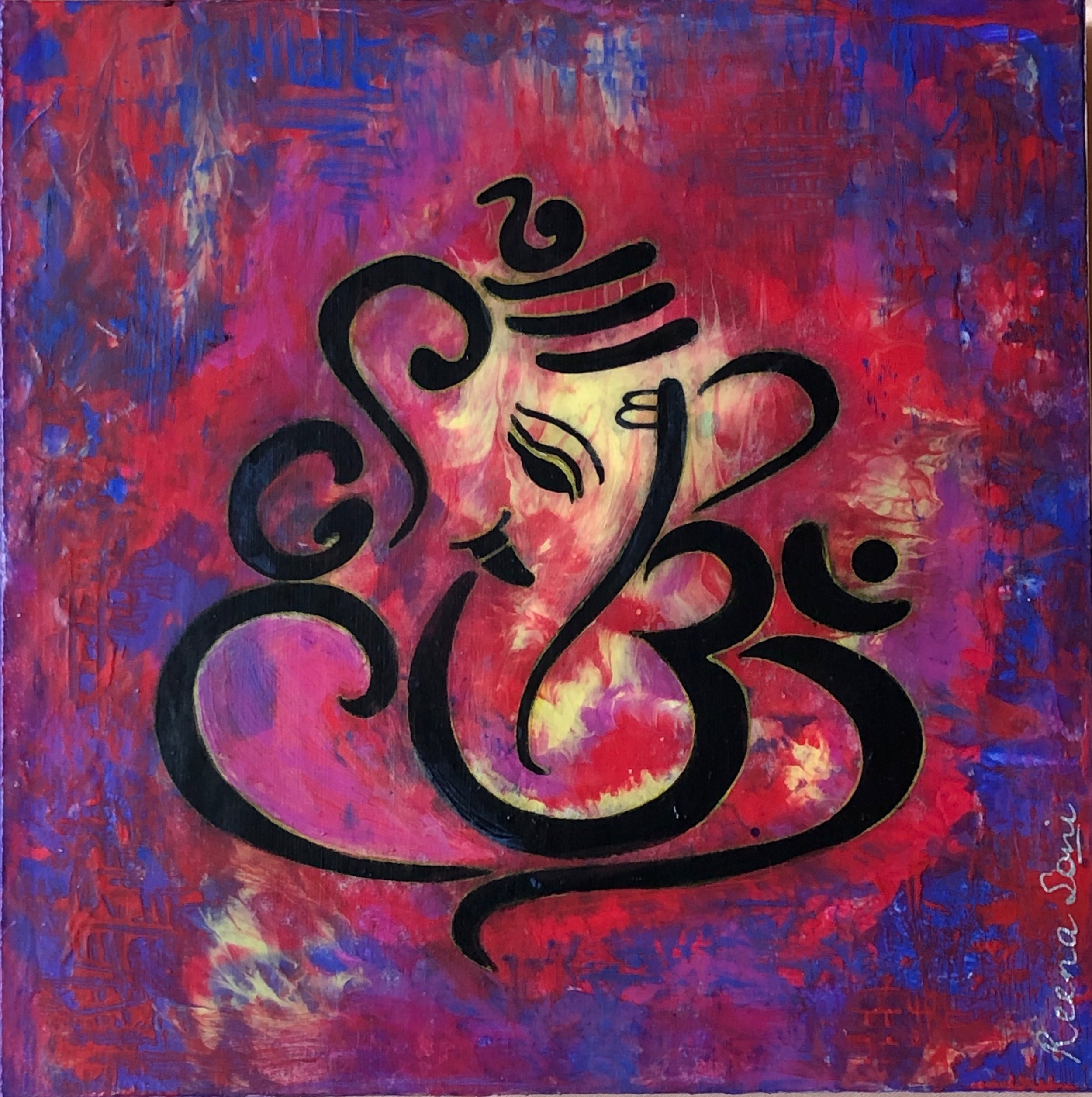
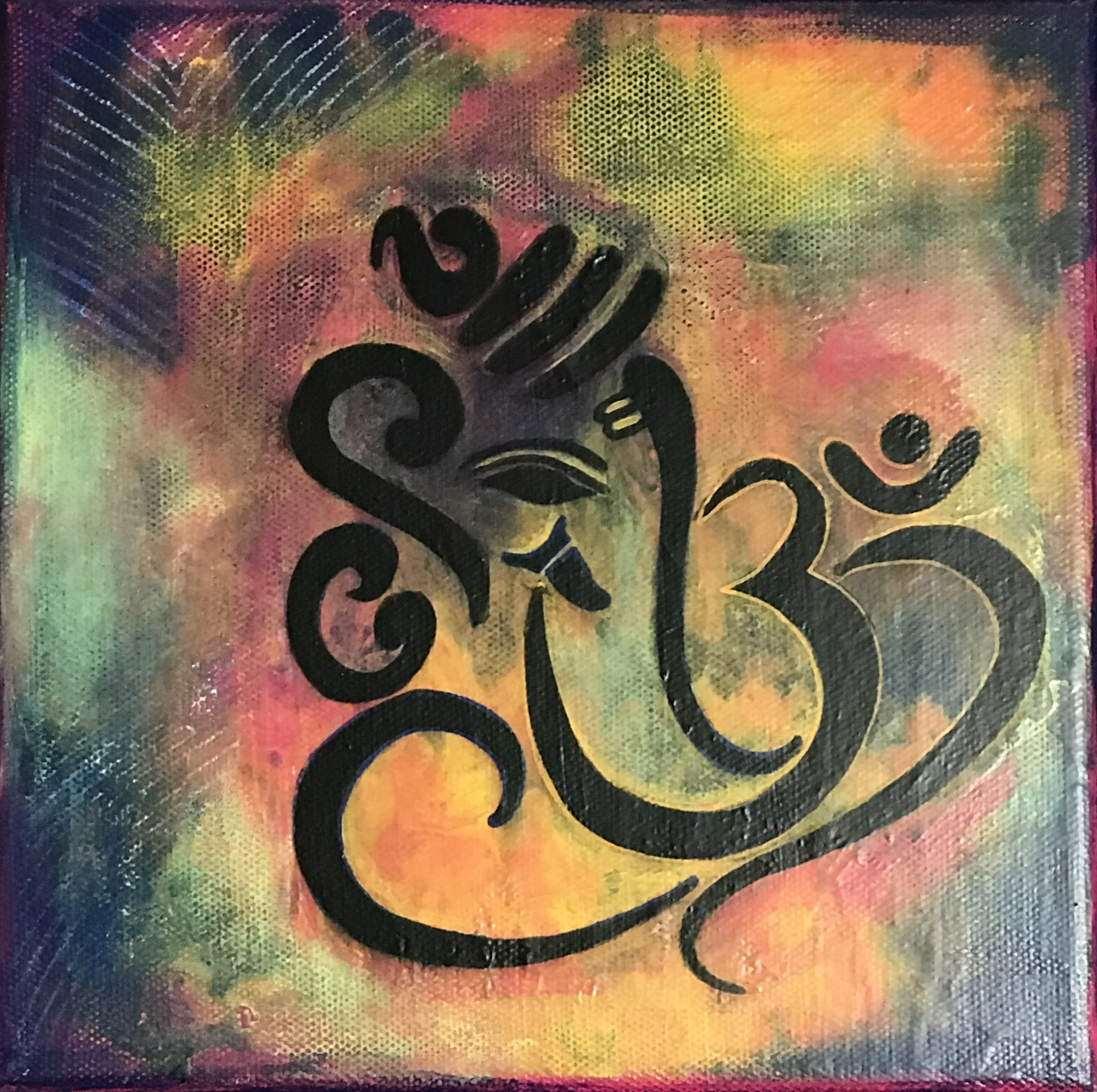





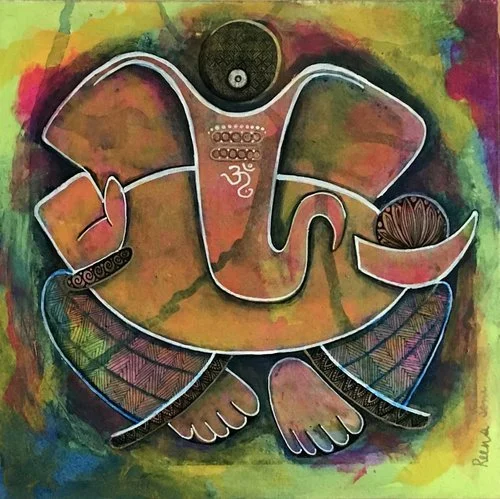



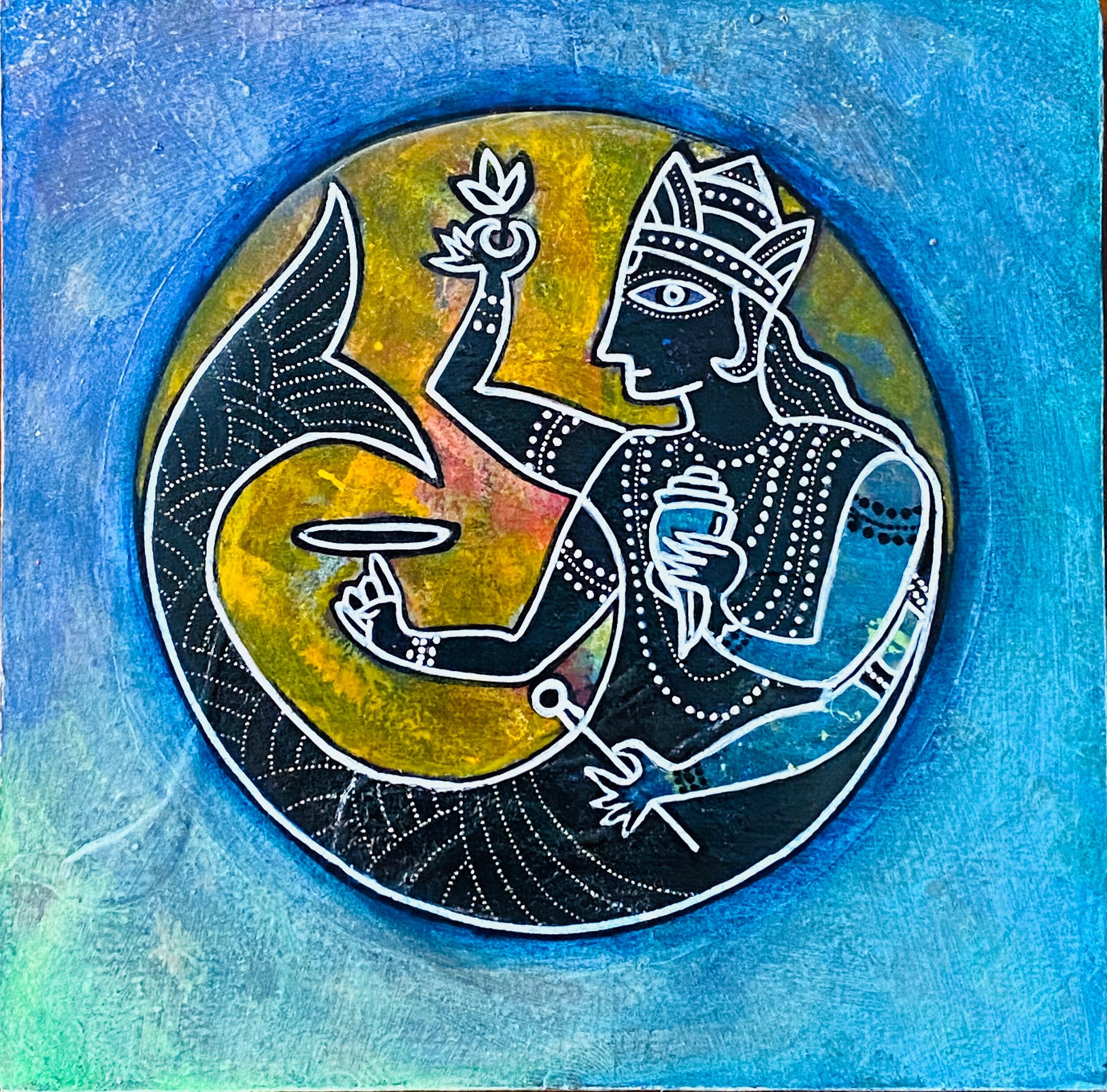

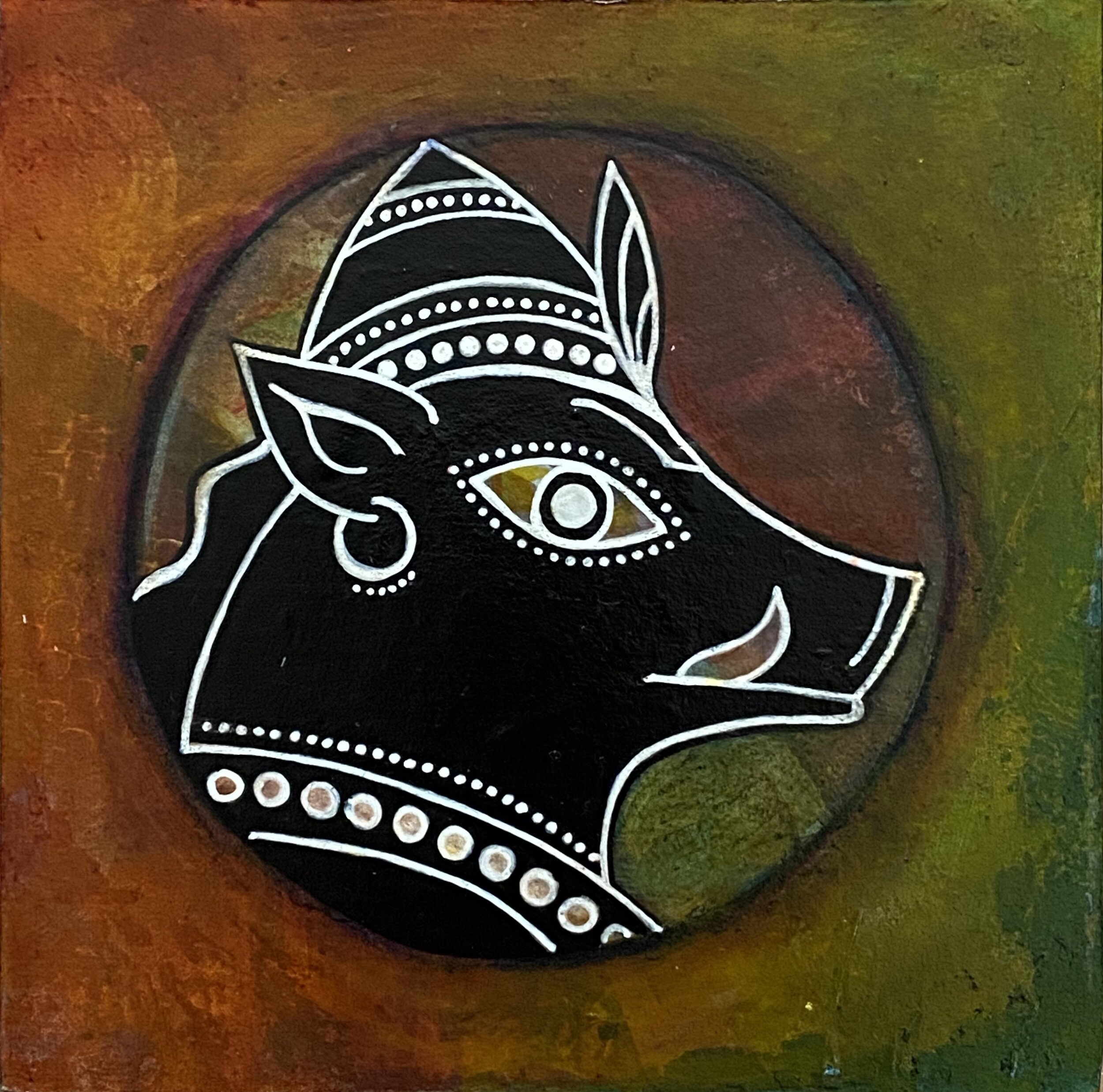
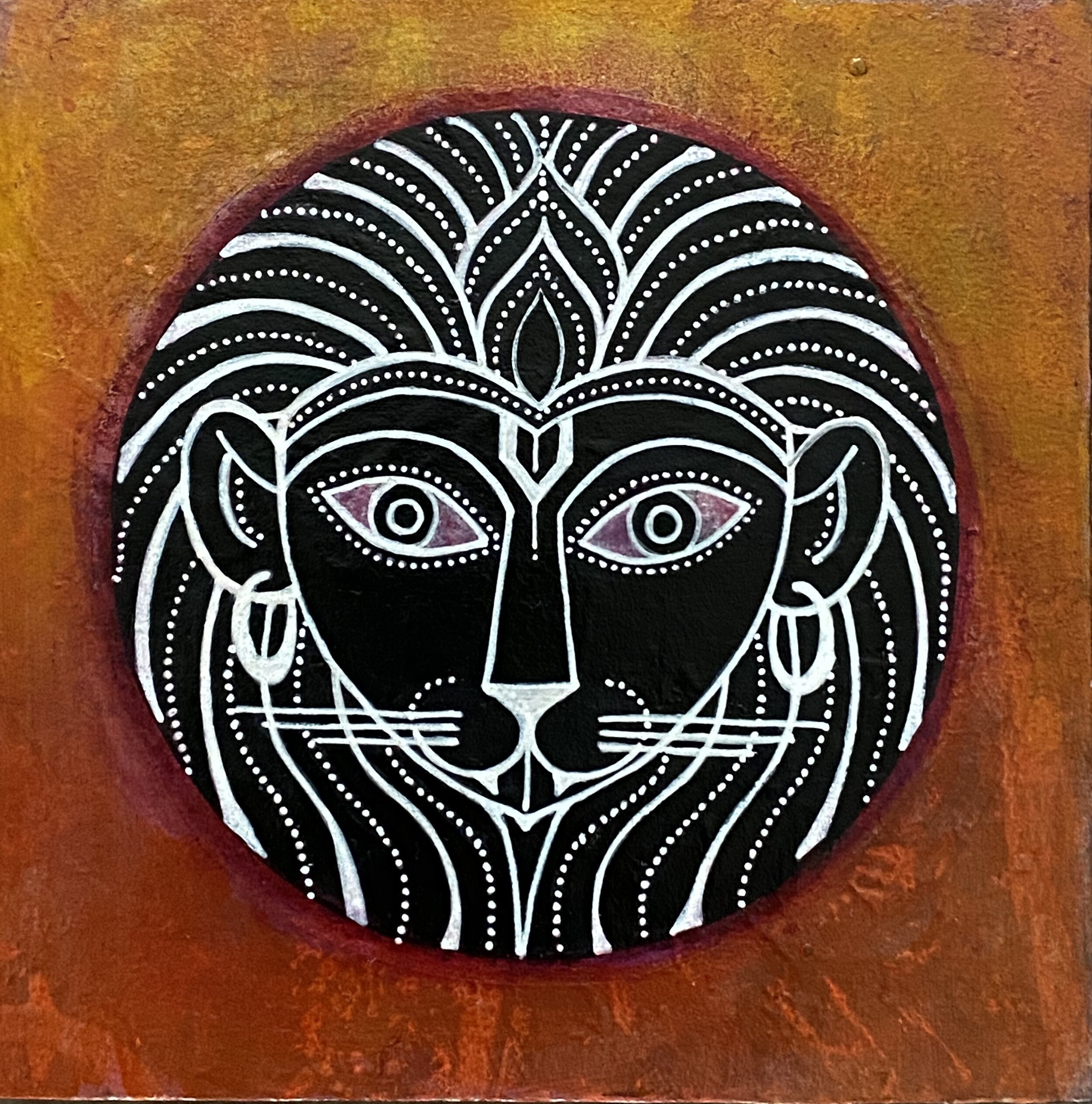

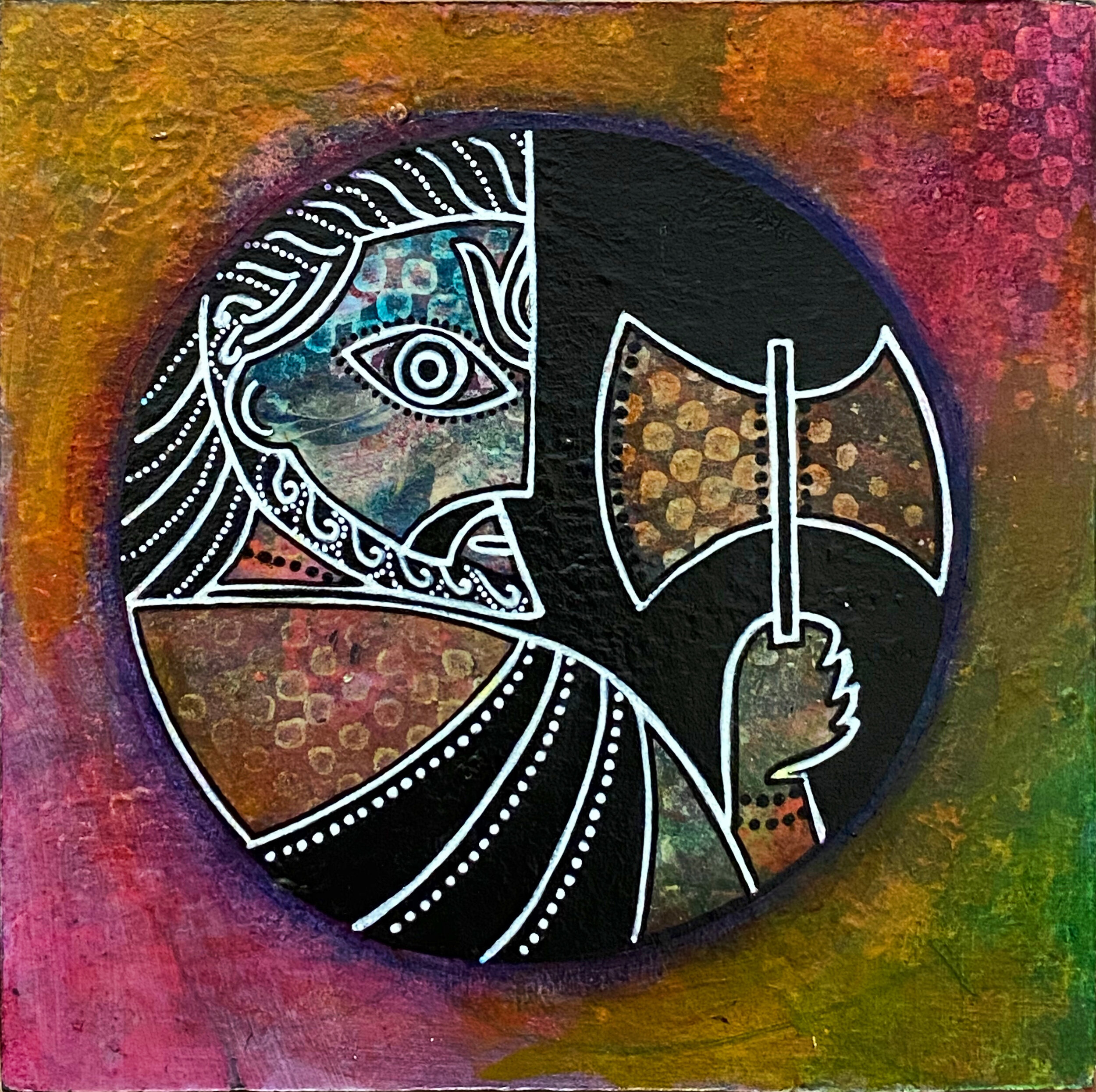

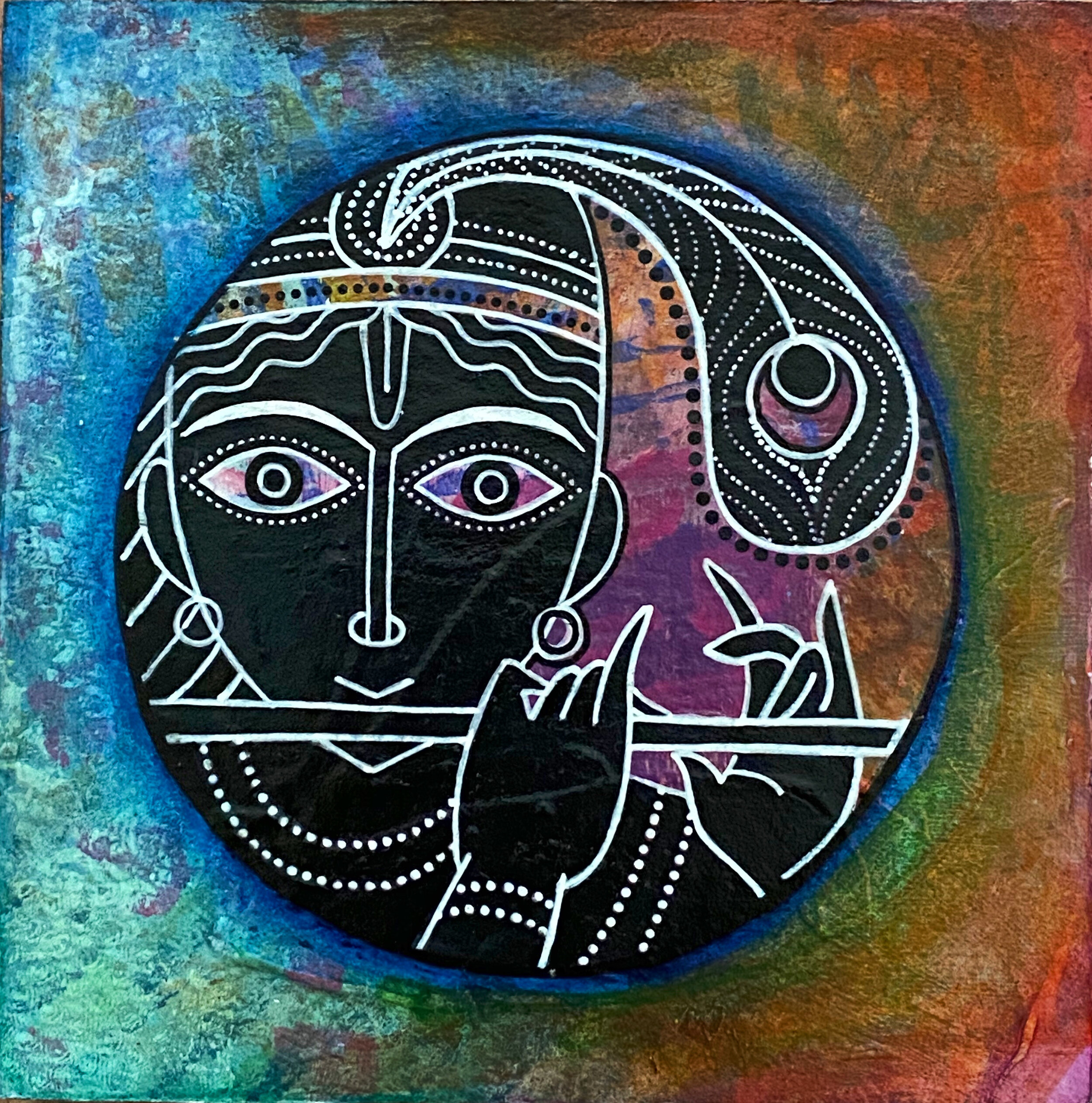
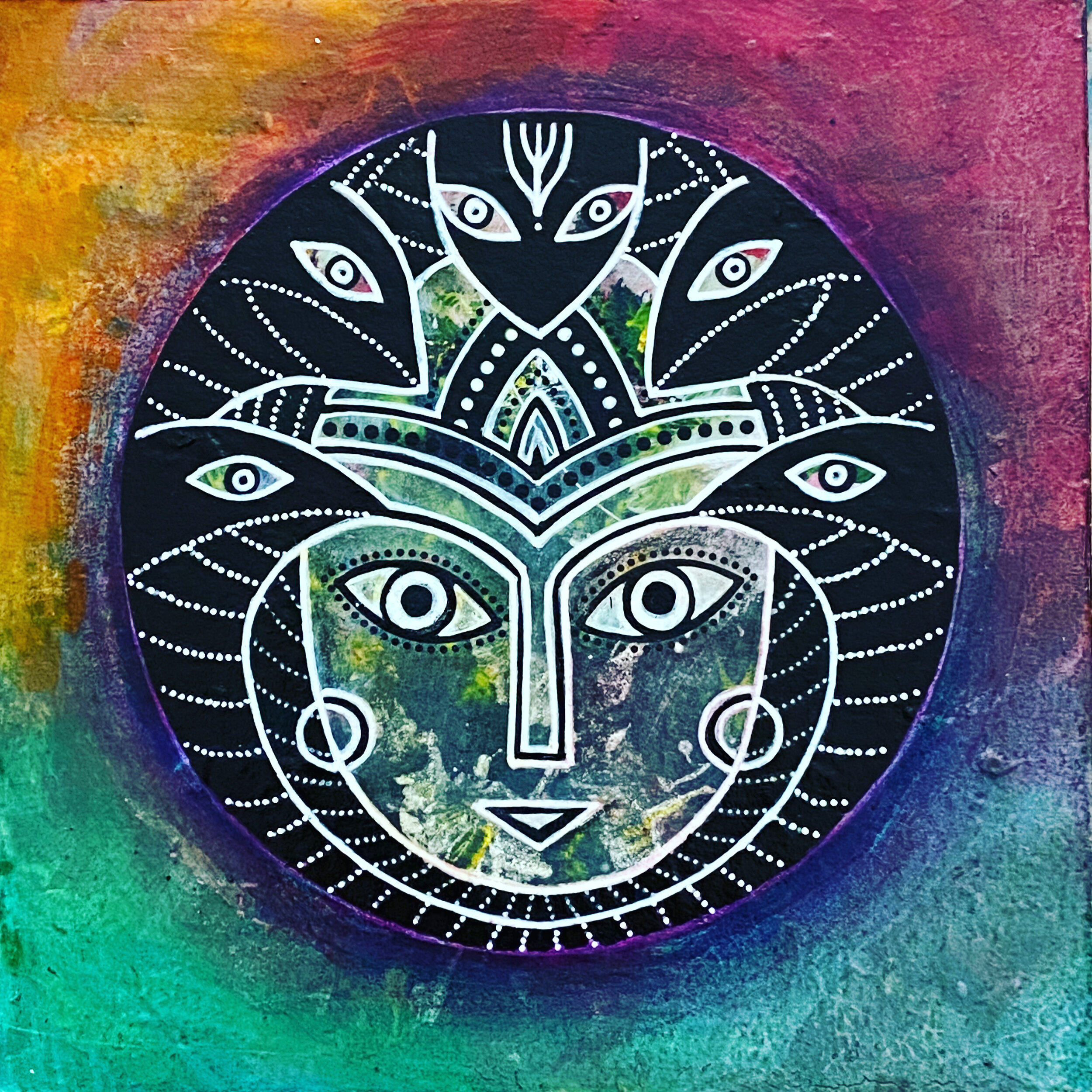
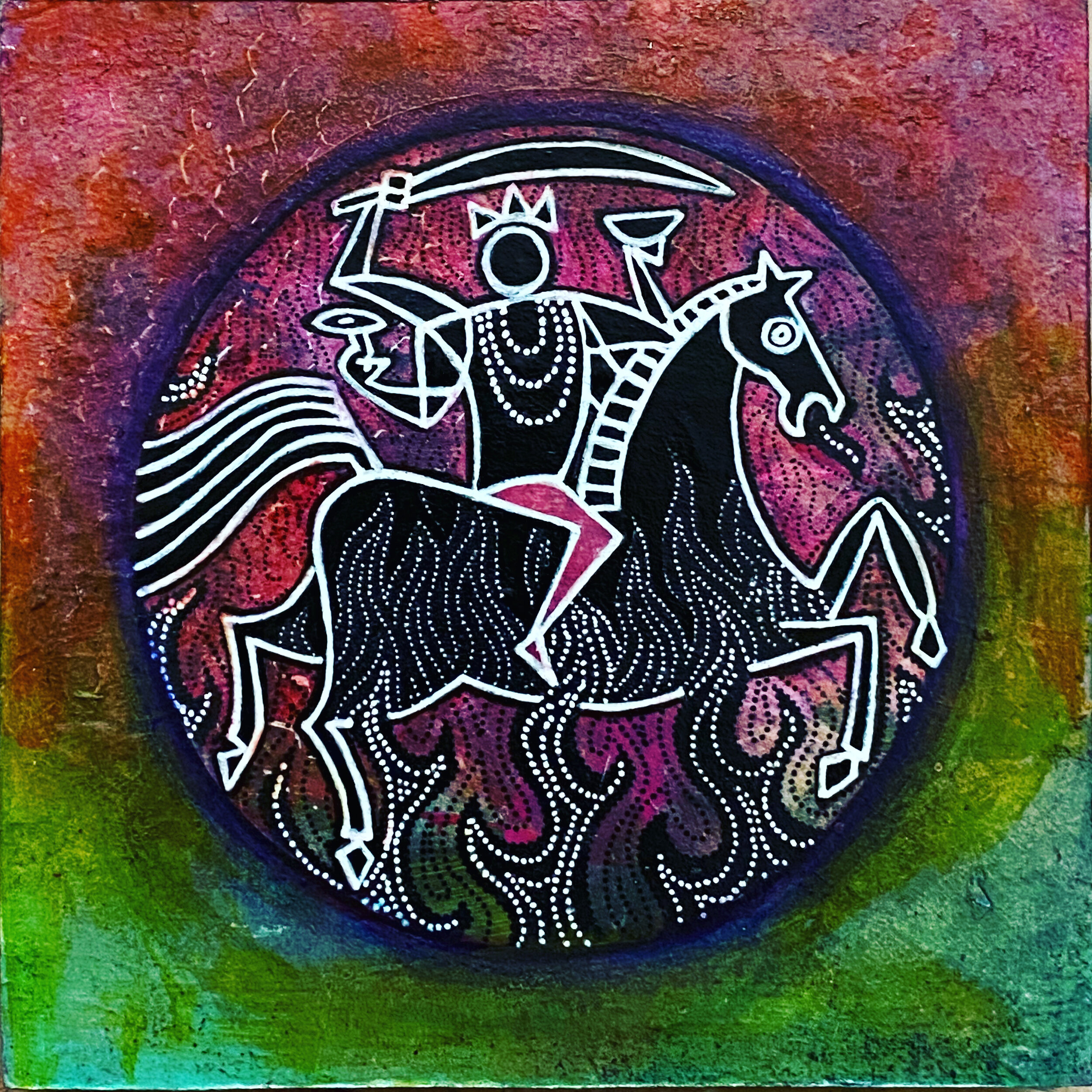


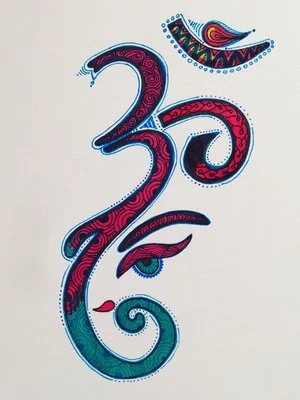

Inspired by the ongoing debate about the power of science vs. the power of god to heal the body and mind. My perspective on needing both powers to be in sync to help us through life. Who else better exemplify science and god other than Leonardo da Vinci as the script in the background and Lord Ganesha to shine through on top.

The Vitaraka (teaching or discussion) mudra is used with Buddhist iconography to symbolize the transmission of the dharma, or the truth teachings of the Buddha. In this mudra, the thumb and index fingers touch, creating a circle that symbolizes an uninterrupted flow of wisdom. The other three fingers pointing up towards the heavens with the palm facing outward. This is held at around chest level. This mudra can invite receiving and discussing teachings for growth and awakening into your life. Rooms such as a library, study, and or the Gen/Knowledge area of the home would benefit from imagery of this mudra.

8x10 Acrylic on Wood Cradle Frame
he Buddha head holds the secrets of enlightenment within it representing the wisdom, and knowledge of the Buddha. The Buddha head statues and art are normally depicted with curly, short hair, to show that the Prince Siddhartha had cut off his topknot to renounce his prince-hood and his privileged past. Ushnisha is one of the most unique features of Buddhist art and Buddhist iconography.
The Ushnisha, or the crown of hair, is the three-dimensional oval at the top of the head of the Buddha.
The facial structure of the Buddha heads usually have half-closed eyes which show a state of meditation: looking inward into the self as well as outward.
The faint smile on the statue also depicts the serene nature and nobility of the Buddha after attaining enlightenment.
The Urna, the spiral or dot between the eyebrows symbolizes a third eye, i.e., vision into the divine world; ability to see past our mundane universe of suffering.
Elongated earlobes in the Buddha heads represent the Buddha's hearing power which is believed that he hears what is needed in the world, the exact reason behind is elongated earlobes may be due the vestiges of his life as a prince, when he wore extravagant and heavy jewellery and earrings on his ears.

9x12 Acrylic on Paper; 12x16 with Mat.
The Buddha head holds the secrets of enlightenment within it representing the wisdom, and knowledge of the Buddha. The Buddha head statues and art are normally depicted with curly, short hair, to show that the Prince Siddhartha had cut off his topknot to renounce his prince-hood and his privileged past. Ushnisha is one of the most unique features of Buddhist art and Buddhist iconography.
The Ushnisha, or the crown of hair, is the three-dimensional oval at the top of the head of the Buddha.
The facial structure of the Buddha heads usually have half-closed eyes which show a state of meditation: looking inward into the self as well as outward.
The faint smile on the statue also depicts the serene nature and nobility of the Buddha after attaining enlightenment.
The Urna, the spiral or dot between the eyebrows symbolizes a third eye, i.e., vision into the divine world; ability to see past our mundane universe of suffering.
Elongated earlobes in the Buddha heads represent the Buddha's hearing power which is believed that he hears what is needed in the world, the exact reason behind is elongated earlobes may be due the vestiges of his life as a prince, when he wore extravagant and heavy jewellery and earrings on his ears.

Inspired by the story when once Brahma the creator, and Vishnu the preserver of the universe wanted to find Shiva and understand him completely. Brahma said, “I will look for his head and you find his feet” so for thousands of years Vishnu went downwards to find Shiva’s feet and Brahma went upwards to find his head finally when they met each other back where they began they realized that there is no beginning and no end to Shiva. He is Ananta Vistara (of infinite expanse) and the fourth state of consciousness that is beyond waking, sleeping or dreaming encompassing this infinite universe.

Trishula or the Trident is a prominent Hindu symbol that is associated with Lord Shiva. Though this three-pronged symbol is usually viewed as a weapon used by the Lord for the protection and restoration of Dharma, it actually carries deeper meanings. They represent three of the fundamental power of Shiva: will (icchya), action (kriya) and jnana (knowledge). This represents that he can destroy evil and ignorance. It also represents that the evildoers are punished by the Lord in three planes: spiritual, subtle and physical. It is representative of the Trinity of Brahma, Vishnu and Mahesh and stands for the balance between the forces of creation, preservation and destruction. It is also considered symbolic of the three Gunas – Rajas, Tamas and Sattva.

Buddham saranam gacchami. - I take refuge in the Buddha.
Dhammam saranam gacchami. - I take refuge in the Dharma.
Sangham saranam gacchami. - I take refuge in the Sangha.

Lord Vishnu incarnates himself as a fish (Matsya Avatar)
Dashavatara refers to the ten avatars of Vishnu, the Hindu god of preservation. The word Dashavatara derives from daśa, meaning ‘ten’ and avatar (avatāra), meaning ‘descent’. God Vishnu incarnates/descends on Earth to eradicate evil forces, to restore the cosmic law and order. These Avatars played a major role in shaping human evolution through centuries.
Lord Vishnu made an appearance before king Manu and told him that the world was at the brink of extinction due to a huge flood in seven days and requested the king to build a huge boat and take the seven sages (Hermits), seeds of all plants, one male and female of every animal species. The whole world was washed up in rain and as a result there was no land to stay. Lord Vishnu appeared in form of a fish (matsya) with horns came to the rescue and the king tied the boat to the fish by using the royal serpent Vasuki and the fish took all of them at great speed to the Himalayas and kept them there till the flood was over and procreation for the new era began.
Illustration Credit - Nina Paley

Lord Vishnu incarnates himself as a Tortoise (Kurma Avatar)
In the ongoing saga of battle between the gods (Devas) and demons (Asuras), the Devas approached Lord Vishnu for help. Vishnu suggested they churn the “Ocean of Milk” in order to make “Amrita”, the nectar of immortality with serpent Vasuki as the rope and the mountain Mandara as the churning staff. He told the gods to request the help of Asuras in lifting the mountain in exchange giving them some of nectar of immortality. But as churning was proceeding the mountain started to sink, and so Lord Vishnu took the form of a tortoise (Kurma Avatar) to bear the weight of the mountain to keep it afloat. But as soon as the nectar of immortality was released the asuras grabbed it for themselves angering the gods. Then Lord Vishnu took the form of an apsara Mohini a beautiful maiden, and seduced the asuras into letting her distribute the nectar and also to abide by her order of distribution. As soon as the gods were served the maiden disappeared thus totally deceiving the asuras and making them totally weak and losing the war against the gods. Illustration Credit - Nina Paley
In the ongoing saga of battle between the gods (Devas) and demons (Asuras), the Devas approached Lord Vishnu for help. Vishnu suggested they churn the “Ocean of Milk” in order to make “Amrita”, the nectar of immortality with serpent Vasuki as the rope and the mountain Mandara as the churning staff. He told the gods to request the help of Asuras in lifting the mountain in exchange giving them some of nectar of immortality. But as churning was proceeding the mountain started to sink, and so Lord Vishnu took the form of a tortoise (Kurma Avatar) to bear the weight of the mountain to keep it afloat. But as soon as the nectar of immortality was released the asuras grabbed it for themselves angering the gods. Then Lord Vishnu took the form of an apsara Mohini a beautiful maiden, and seduced the asuras into letting her distribute the nectar and also to abide by her order of distribution. As soon as the gods were served the maiden disappeared thus totally deceiving the asuras and making them totally weak and losing the war against the gods. Illustration Credit - Nina Paley

Lord Vishnu incarnates himself as a Boar (Varaha Avatar)
Dashavatara refers to the ten avatars of Vishnu, the Hindu god of preservation. The word Dashavatara derives from daśa, meaning ‘ten’ and avatar (avatāra), meaning ‘descent’. God Vishnu incarnates/descends on Earth to eradicate evil forces, to restore the cosmic law and order.
When the demon Hiranyaksha stole the earth (Goddess Bhudevi) and hid her in the primordial waters, Vishnu appeared as “Varaha” (boar) to rescue her. The battle between Varaha and Hiranyaksha is believed to have lasted for a thousand years. Varaha finally slew the demon and retrieved the Earth from the ocean, lifting it on his tusks, and restored Bhudevi to her place in the universe. Varaha may be depicted as completely a boar or in an anthropomorphic form, with a boar's head and the human body. His consort, Bhudevi, the earth, is often depicted as a young woman, lifted by Varaha.
Illustration Credit - Nina Paley

Lord Vishnu incarnates himself as a semi-man, semi-lion (Narasimha Avatar)
The king of demons, Hiranyakasyapa, wanted to become immortal so he performed severe penance to impress Lord Brahma to grant him a wish. Hiranyakasyapa wished that he be neither killed by a man or beast, nor in daylight or at night and neither inside or outside a building, on earth or the stars, with a weapon either living or inanimate.
Having obtained the immortality wish he considered himself the supreme God and forbade all worship of gods by anyone. But his son Prahlada, was an ardent devotee of Lord Vishnu. This enraged Hiranyakasyapa very much and ordered numerous ways to kill Prahlada including asking his sister Holika to sit with Prahlada in the fire. But everytime Prahlada escaped unhurt. Enraged, once he asked Prahlad to show him the Lord Vishnu. Prahlad said, "He is everywhere". Further enraged, Hiranyakasyapa knocked down a pillar, and asked if Lord was present there. Lord Vishnu descended as an anthropomorphic incarnation, with the body of a man and head and claws of a lion. He then disembowels the demo at the courtyard threshold of his house, at dusk, with his claws, while he lay on his thighs thus saving the life of his devotee Prahlada.
Illustration Credit - Nina Paley

Lord Vishnu incarnates himself as a dwarf priest (Vamana Avatar)
The fourth descendant of Hiranyakashyap/grandson of Prahlad, Demon King Mahabali, with devotion and penance was able to defeat Indra, the god of firmament. This humbled the other deities and extended his authority over the three worlds. The gods appealed to Lord Vishnu for protection and he incarnated as the dwarf Vamana. During a yajna (ritual sacrifice with a specific objective) of the king, Vamana approached him and Bali promised him for whatever he asked. Vamana asked for three paces of land. After Bali agreed, and the dwarf then changed his size to that of a giant. He stepped over heaven in his first stride, and the netherworld with the second. Bali realized that Vamana was Vishnu incarnate. In deference, the king offered his head as the third place for Vamana to place his foot. The avatar did so and thus granted Bali immortality. Then in appreciation to Bali and his grandfather Prahlada, Vamana made him ruler of Pathala, the netherworld. Vamana taught King Mahabali that pride should be abandoned for advancement in life, and that wealth should be appreciated as it can easily disappear.
Illustration Credit - Nina Paley

Lord Vishnu incarnates himself as a warrior saint (Parashurama Avatar)
Parashuram, the son to Jamadagni and Renuka, was the first Brahmin-Kshatriya in Hinduism, or warrior-saint, with duties between a Brahmana (priest) and a Kshatriya (warrior). He was always carrying an axe presented to him by Lord Shiva of whom he was an ardent devotee. Lord Vishnu incarnated to avenge all kshatriyas who had become arrogant and were suppressing the brahmans in the world. King Kartavirya and his army visited the father of Parashurama at his ashram, and the saint was able to feed them with the endless supply of milk from the divine cow “Kamadhenu”. The king demanded he have the animal but Jamadagni refused, so the king took it by force and destroyed the ashram. Parashurama enraged with the act killed the king at his palace and destroyed his army. In revenge, the sons of Kartavirya killed Jamadagni. Then Parashurama took a vow to kill every Kshatriya on earth twenty-one times over. Ultimately it was his grandfather, Sage Rucheeka who made him halt this cycle of killing. He is one of the seven immortals mentioned in the scriptures believed to be alive today in penance at Mahendragiri.
Illustration Credit - Nina Paley

Lord Vishnu incarnates himself as Rama (Rama Avatar)
The epic Ramayana is a story of the war raged by Rama against various evil elements of the world and in the end against Ravana, the demon king of Lanka (demon with ten heads). The character Rama (Vishnu Incarnate) is expected to show the world the characteristics of an ideal person, including ideal son, ideal husband, ideal king and an ideal person. For the sake of his father’s honor, Ram abandons his claim to Ayodhaya’s throne to serve an exile of fourteen years in the forest. While in exile from his own kingdom with his brother Lakshman and his wife Sita (Lakshmi Incarnate) who was abducted by the demon king Ravana (who had been granted a boon by God Brahma with immunity from the gods, and other celestial beings therefore was too vainglorious). Lord Rama with the help of Lord Hanuman (monkey king) and his monkey men army was able to killed the demon king and saved Goddess Sita.
Illustration Credit - Nina Paley

Lord Vishnu incarnates himself as Lord Krishna
Krishna is a major deity in Hinduism. He is worshipped as the eighth avatar of the god Vishnu in Vaishnava belief and also as the supreme God in his own right. Lord Vishnu incarnates himself as Krishna, the central character in the epic Mahabharata. In the biggest epic of Indian mythology a myriad of topics are covered, including war, love, brotherhood, politics etc. It is essentially the story of two warring groups of cousin brothers, the Pandavas and the Kauravas. As a part of the Mahabharata, during the war lord Krishna, gives a long discourse to his disciple Arjuna, and it is now known as the “Bhagvad-Gita”. Unlike Ramayan, Mahabharata deals with more down to earth issues like politics, human nature, human weaknesses, and does not attempt to idealize the characters as in Ramayan.
Illustration Credit - Nina Paley

Shesha incarnates himself as Balarama
Shesha Sheshanaga or Adishesha is the King of all Nāgas (semi-divine race of half-human half-serpent beings) and one of the primal beings of creation. Sometimes he is shown as five-headed or seven-headed, but more commonly as a many thousand-headed serpent, sometimes with each head wearing an ornate crown. In the Puranas, it is said that when Adishesa uncoils, time moves forward and creation takes place; when he coils back, the universe ceases to exist. Vishnu is often depicted as resting on Shesha. He is said to have descended to Earth in three avatars: Lakshmana, brother of Vishnu's avatar Rama and as Balarama, brother of Vishnu's avatar Krishna and Ramanujacharya, the proponent of Vishishtadvaita school of Vedanta. "Shesha" in Sanskrit texts, especially those relating to mathematical calculation, implies the "remainder"—that which remains when all else ceases to exist.
Balarama, the elder brother of Krishna, is regarded generally as an avatar of Shesha an extension of Ananta, a form of Lord Vishnu. Balarama is included as the eighth avatar of Vishnu in the Sri Vaishnava lists, where Buddha is omitted and Krishna appears as the ninth avatar in this list. He is particularly included in the lists where Krishna is removed and becomes the source of all.
Illustration Credit - Nina Paley

Lord Vishnu incarnate himself as destroyer of darkness (Kalki Avatar)
The name Kalki is derived from Kal, which means "time”. Kalki, or Kalkin, is the prophesied tenth avatar of the Hindu god Vishnu. His birth will be the end of the Kali Yuga, our present epoch, in the endless cycle of existence. He is described in the Puranas as the avatar who rejuvenates existence by ending the darkest and destructive period by removing all unrighteousness and evil and ushering in the golden age, while riding a white horse with his sword drawn, blazing like a comet. The description and details of Kalki are different among various Puranas. The prophecy of the Kalki avatar is believed not only by the followers of the Vaishnavism sect of Hinduism but by Sikhism and Buddhism as well.
Illustration Credit - Nina Paley

Lord Vishnu incarnates himself as Buddha, the ascetic prince who renounced the throne to lead the world on the path of peace. He is the founder of the Buddhism and in certain sects of Hinduism, he is considered to be a divine incarnation of Lord Vishnu. He was born the crown prince of the Kapilavastu to Suddhodana and Maya. He was named Siddhartha, meaning "All thing fulfilled" by the king. But his mother died soon after his birth but Prajapati, the sister of Maya, brought Siddhartha up. Buddha was saddened by death of living creatures, since his childhood days and used to question: "Alas! Do all living creatures kill each other?" He wasn't happy with any answers that were provided to him and he decided to find out the meaning and the absolute truth and he left his wife and child to a hermit's life in the forest and one day, became the enlightened one. When the world had lost real understanding of the scriptures and was stooped in ignorance (practices without right philosophy), Buddha reiterated the importance of self-realization and self-effort in realizing oneself. He was responsible for the philosophy of Liberation away from the philosophy of heaven and hell. Buddha may be depicted in Hindu scriptures as a preacher who deludes and leads demons and heretics away from the path of the Vedic scriptures. Another view praises him as a compassionate teacher who preached the path of ahimsa (non-violence).
Illustration Credit - Nina Paley